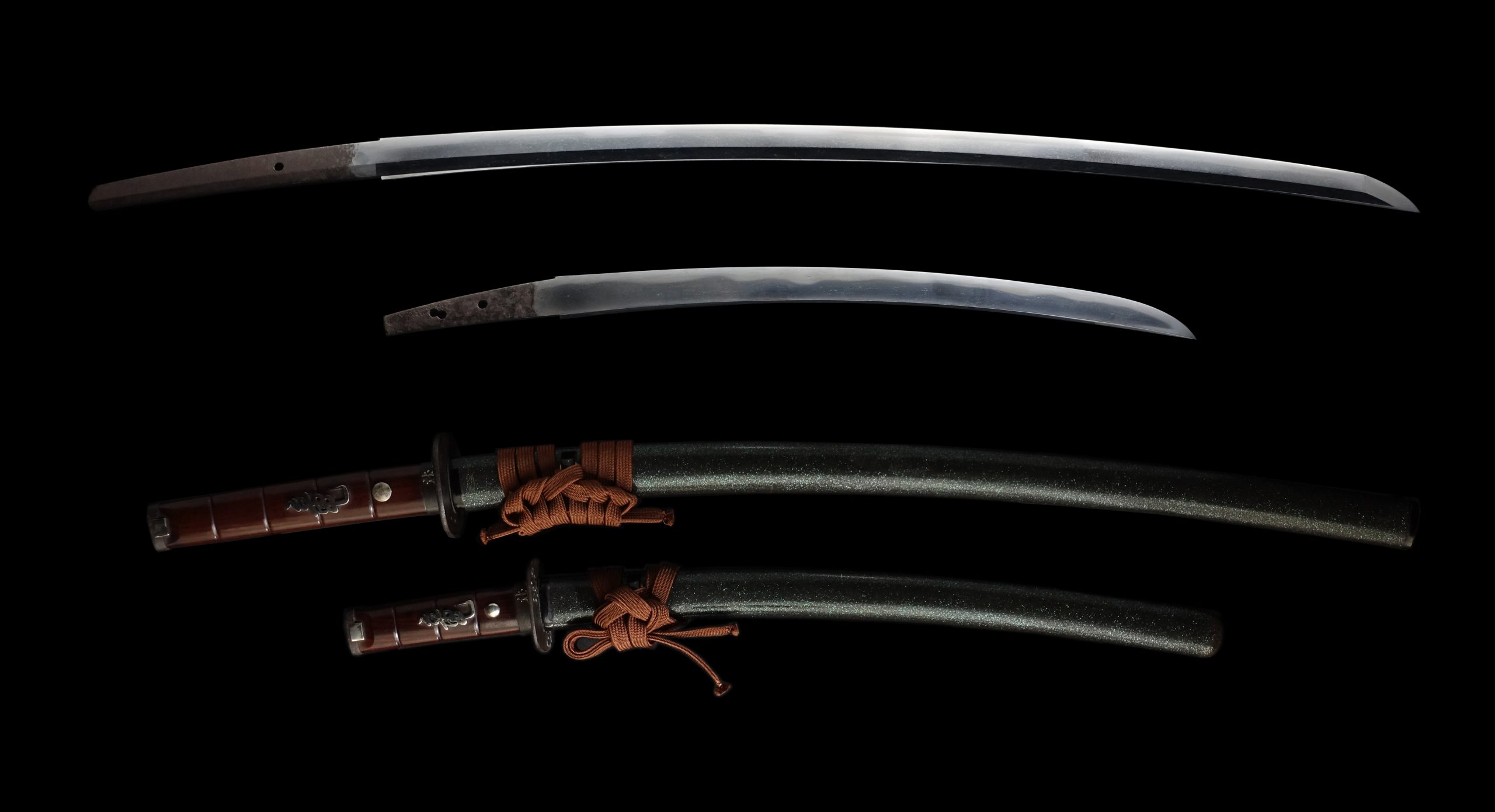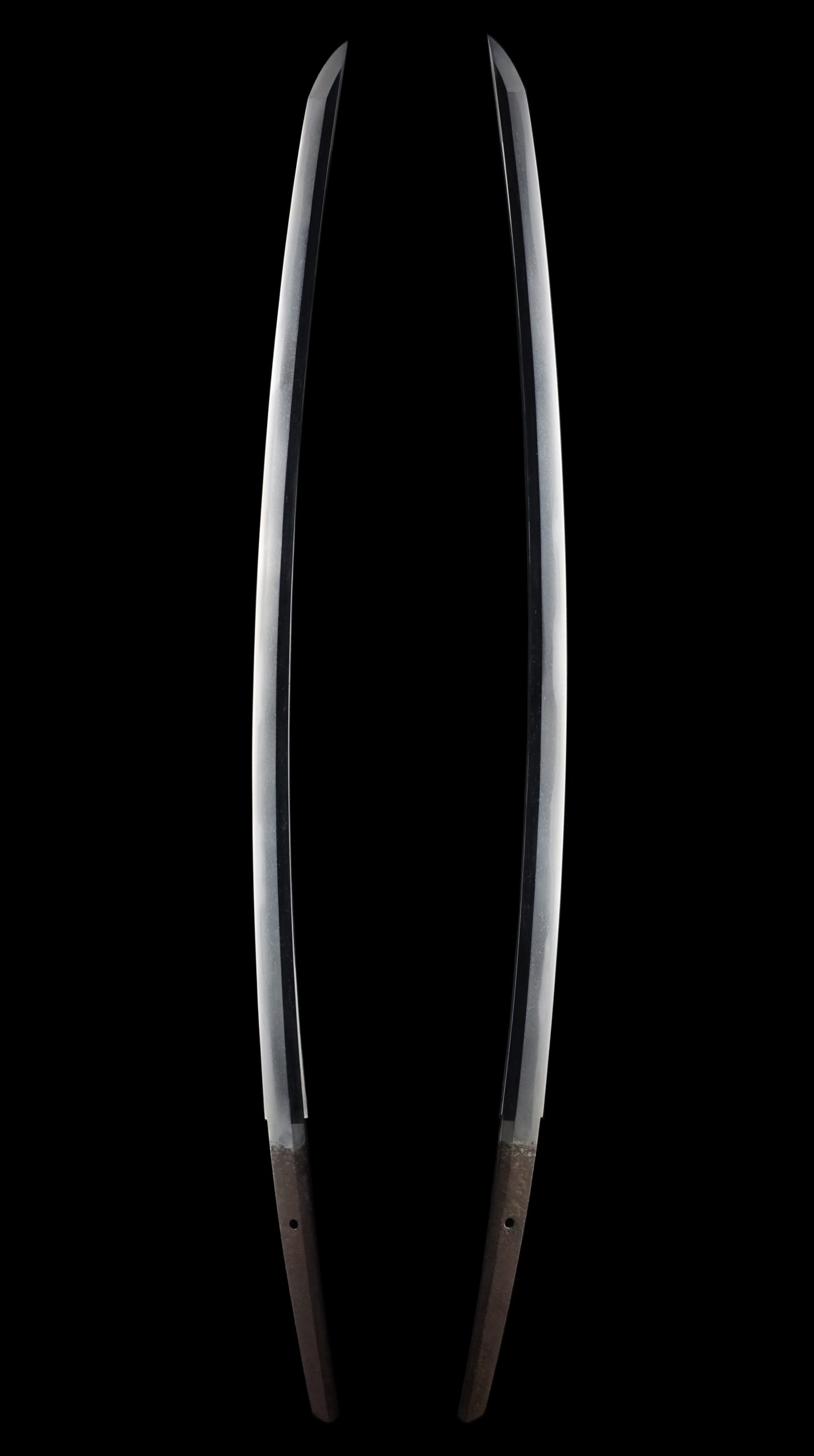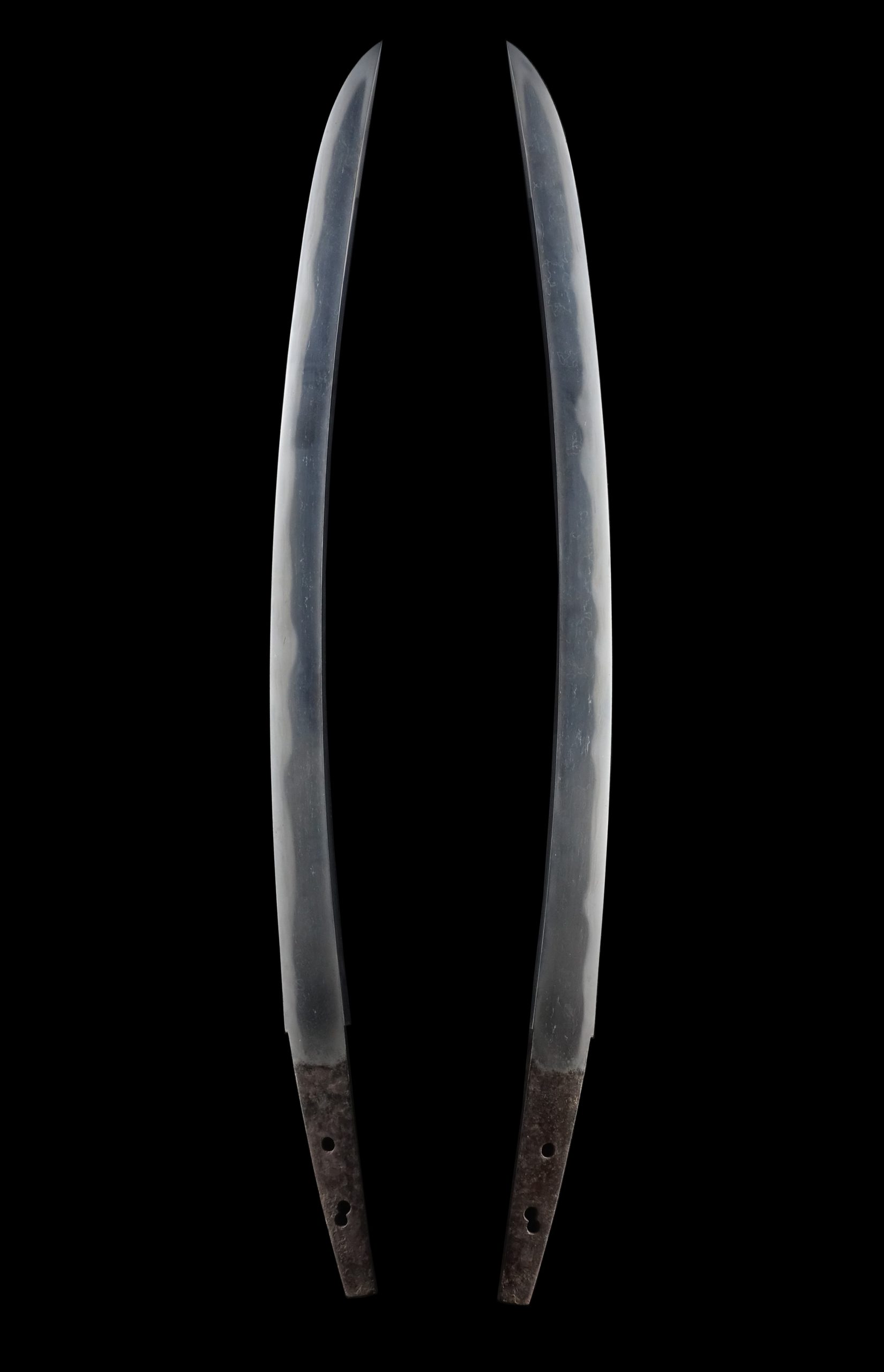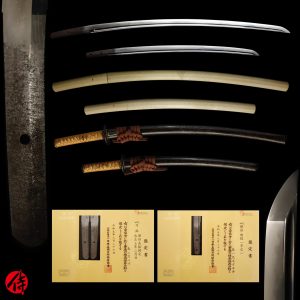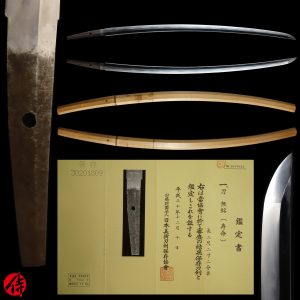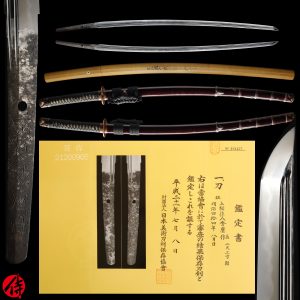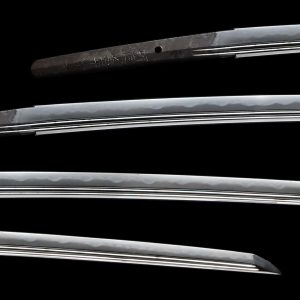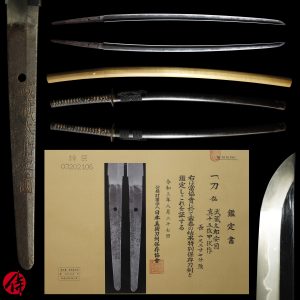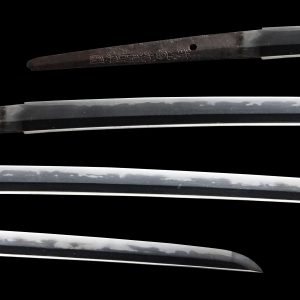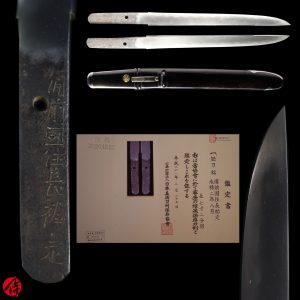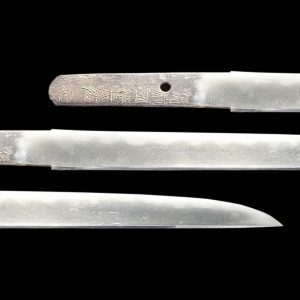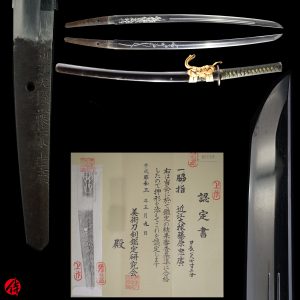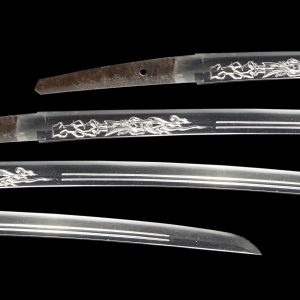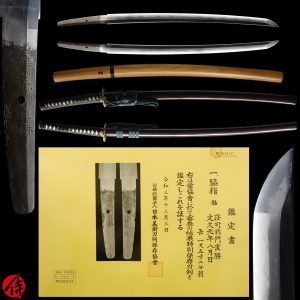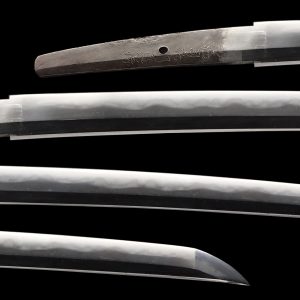Antique Japanese Sword Daisho Unsigned Kanewaka/ Sukemune with Hon-Ami Nisshu Kofuda
【Description】
According to the Kofuda written by Hon-Ami Nisshu, renowned Japanese sword appraiser, the Katana is attributed to the work of Kagakoku Kanewaka(加賀国兼若), and Wakizashi is attributed to the creation of Surugakoku Sukemune(駿河国助宗) while both swords are Mumei(no remained signatures).
The Katana attributed to the work of Kanewaka
According to the appraisal in the Kofuda, it was attributed to the work of Kanewaka in the Tenpo era(1831-1845). The swordsmith name “Kanewaka” lasted a few generations during the Edo period(Early 17th century-late 19th century).
The first-gen Kanewaka was originally from Mino province(today’s Gifu prefecture). Later on, he moved to the Kaga domain(Today’s Ishikawa prefecture) at the beginning of the Edo period after being summoned by Maeda Toshitsune, the third-gen head of the Kaga domain. Kanewaka was known as one of the most famous swordsmiths in the Kaga domain in the early-mid Edo period. It is said that Kanewaka forged swords for those who belonged to the Kaga domain under Maeda clan’s control. All the swordsmiths who signed Kanewaka in the Kaga domain were under the auspice of Maeda clan from generation to generation because of their highly skilled craftsmanship.
The Wakizashi attributed to the work of Sukemune
According to the appraisal in the Kofuda, it was attributed to the work of Sukemune in the Tenbun era(1532-1555).
Sukemune belonged to Shimada school in the Suruga domain(today’s Shizuoka prefecture). Its foundation dates back to the mid-Muromachi period, and it was founded by Yoshisuke. The first-gen Sukemune was the younger brother of Yoshisuke. The swordsmith’s name Sukeume lasted a few generations until the Edo period.
What is Daisho?
Daisho is a pair of two Japanese swords Samurai carried. During the Edo period, having Daisho in public places was considered social status for Samurai. Furthermore, Samurai were required to wear them under the law back then. Daisho is written as 大=Big and 小=Small. Dai part means Katana, and Sho part means Wakizashi. While both swordsmiths don’t have remaining signatures, they come with a pair of Daisho Koshirae(sword mountings).
That means Samurai back then might have carried these pair of Daisho. They have such a fancy appearance that we believe a high-ranked Samurai owned them.
Appraisal
This Daisho set comes with Kofuda written by Hon-Ami Nisshu(本阿弥日州).
He was born in the 41st year of the Meiji era(1908), and he is the son of Hirai Chiba, a renowned Japanese sword polisher. Nisshu trained in polishing and appraising Japanese swords since he was young. Later on, he became an apprentice of Hon-Ami Ringa, mastering appraising antique Japanese swords. He eventually took over the head of the Hon-Ami school. He is known as the 23rd-gen Hon-Ami. He was ordered to polish blades that are designated national treasure and important cultural property of Japan in his career. Nishuu belonged to the judging committee of authentic Japanese swords. He was specialized in both polishing and appraising Japanese swords in modern times.
Hon-Ami school has been trusted Japanese sword appraisers since 1596(Late Azuchi Momoyama period). They issued Origami, authentication paper for Japanese swords in medieval times in Japan during the Edo period.
*Please keep in mind that Kofuda isn’t considered an official authentication paper today, unlike NBTHK or NTHK certificate.
【 Blade】

-Katana
Cutting Edge Length(Nagasa):63.6 cm(25.0 inches)
Curvature(Sori):1.97 cm( 0.78 inches)

-Wakizashi
Cutting Edge Length(Nagasa):31.6 cm( 12.4 inches)
Curvature(Sori):1.51 cm( 0.60 inches)

Hamon:
The crystalline structure which forms along the cutting edge of a blade as a result of the hardening process
Jimon(Jihada):
visible steel surface pattern created by folding and hammering during forging process
-Katana
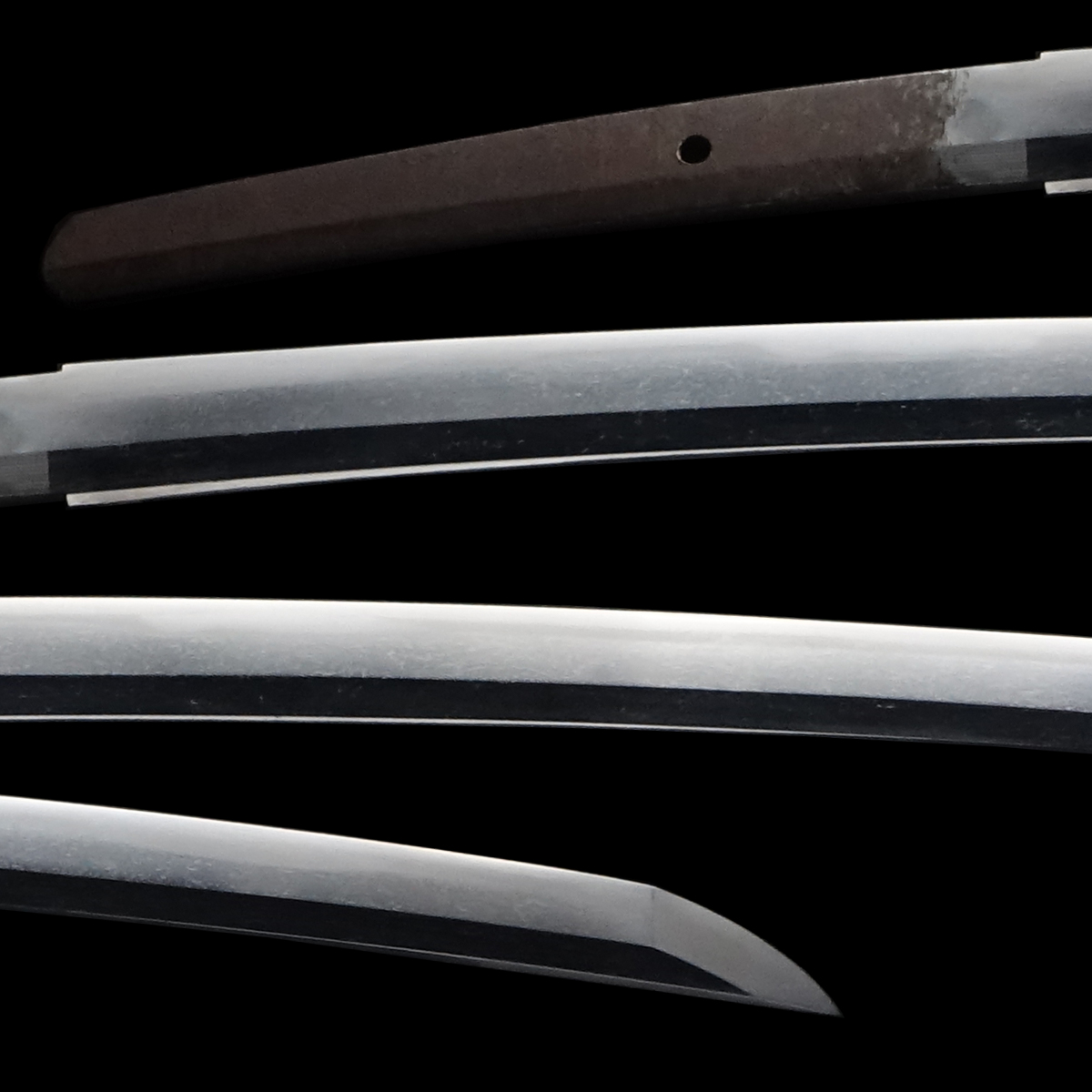
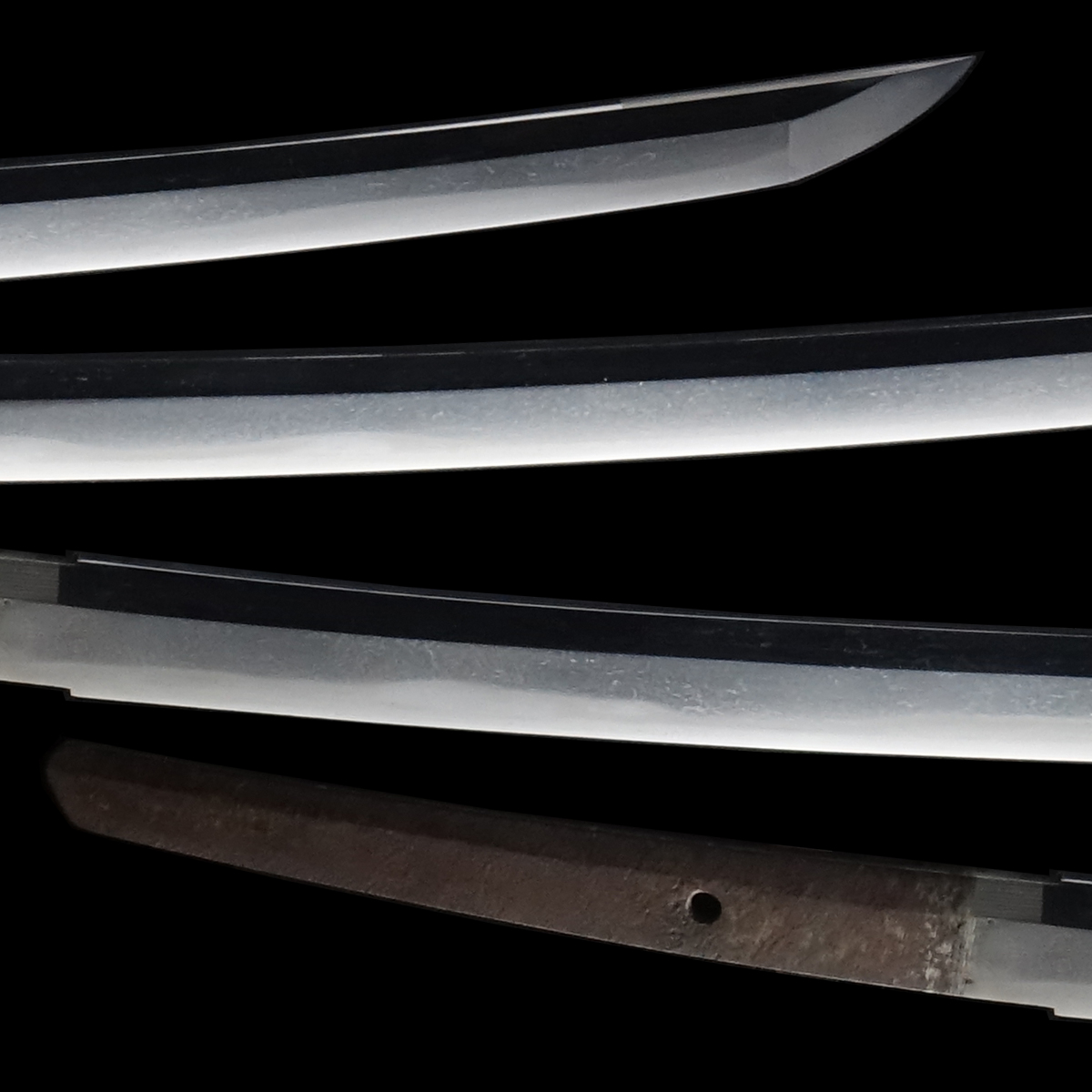
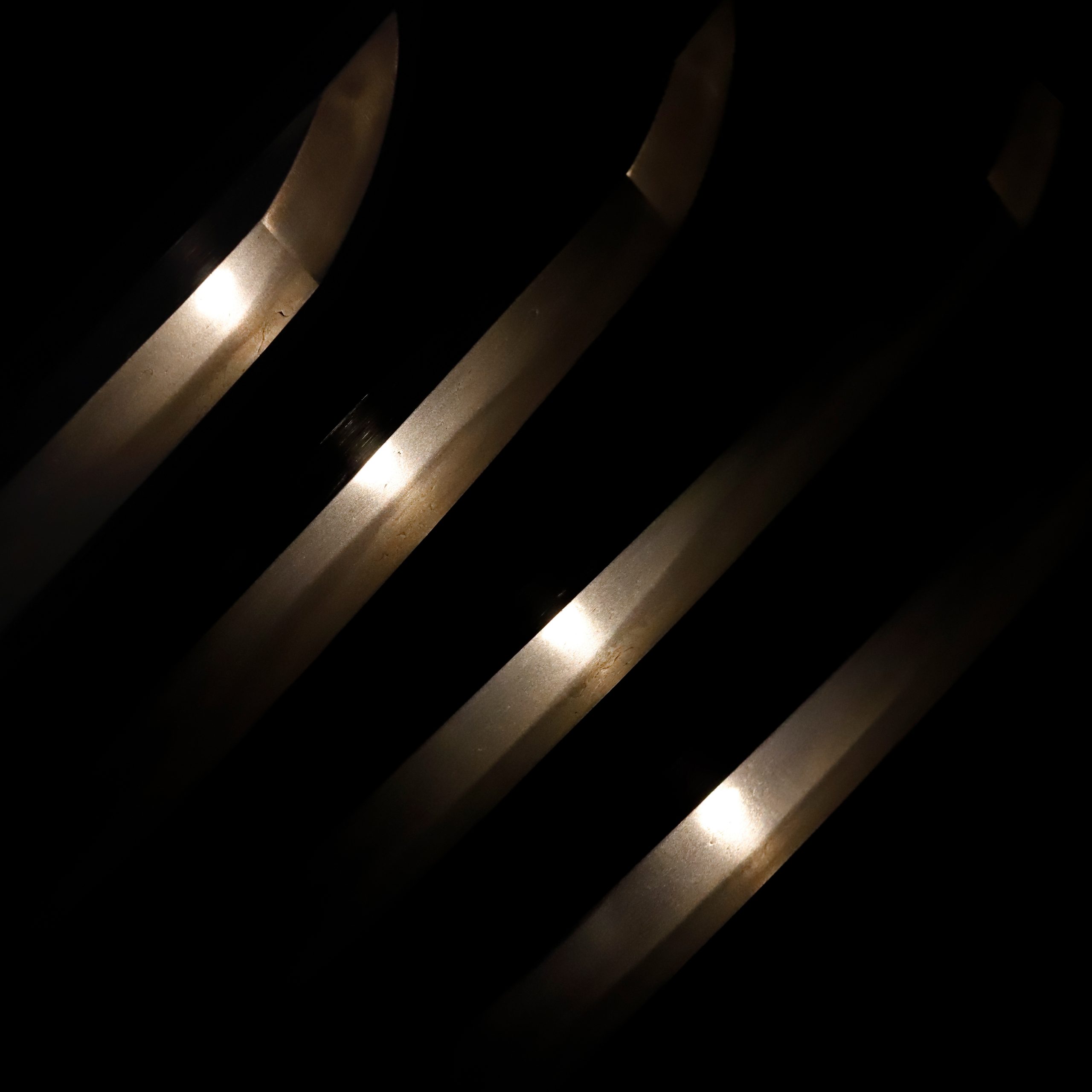

-Wakizashi
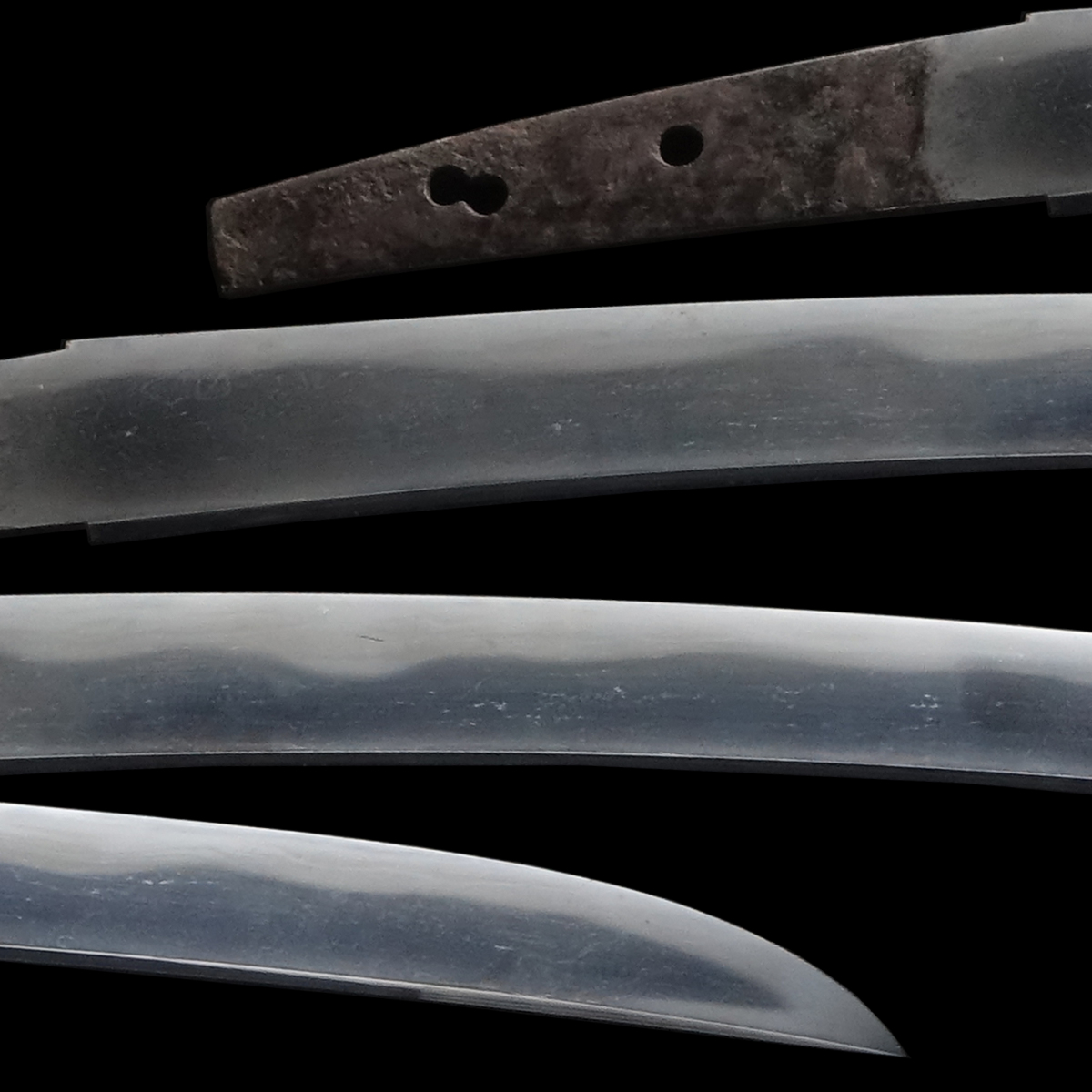
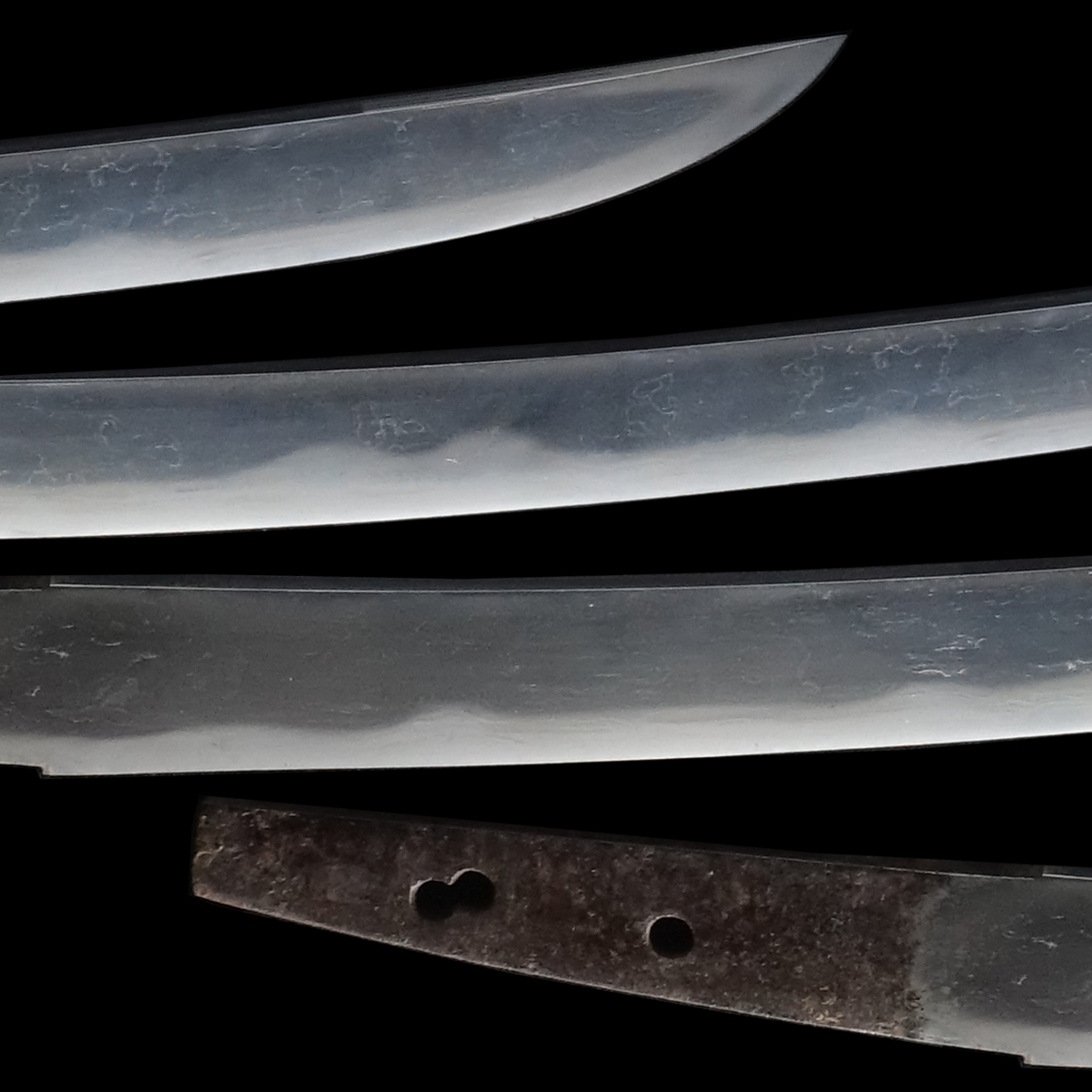
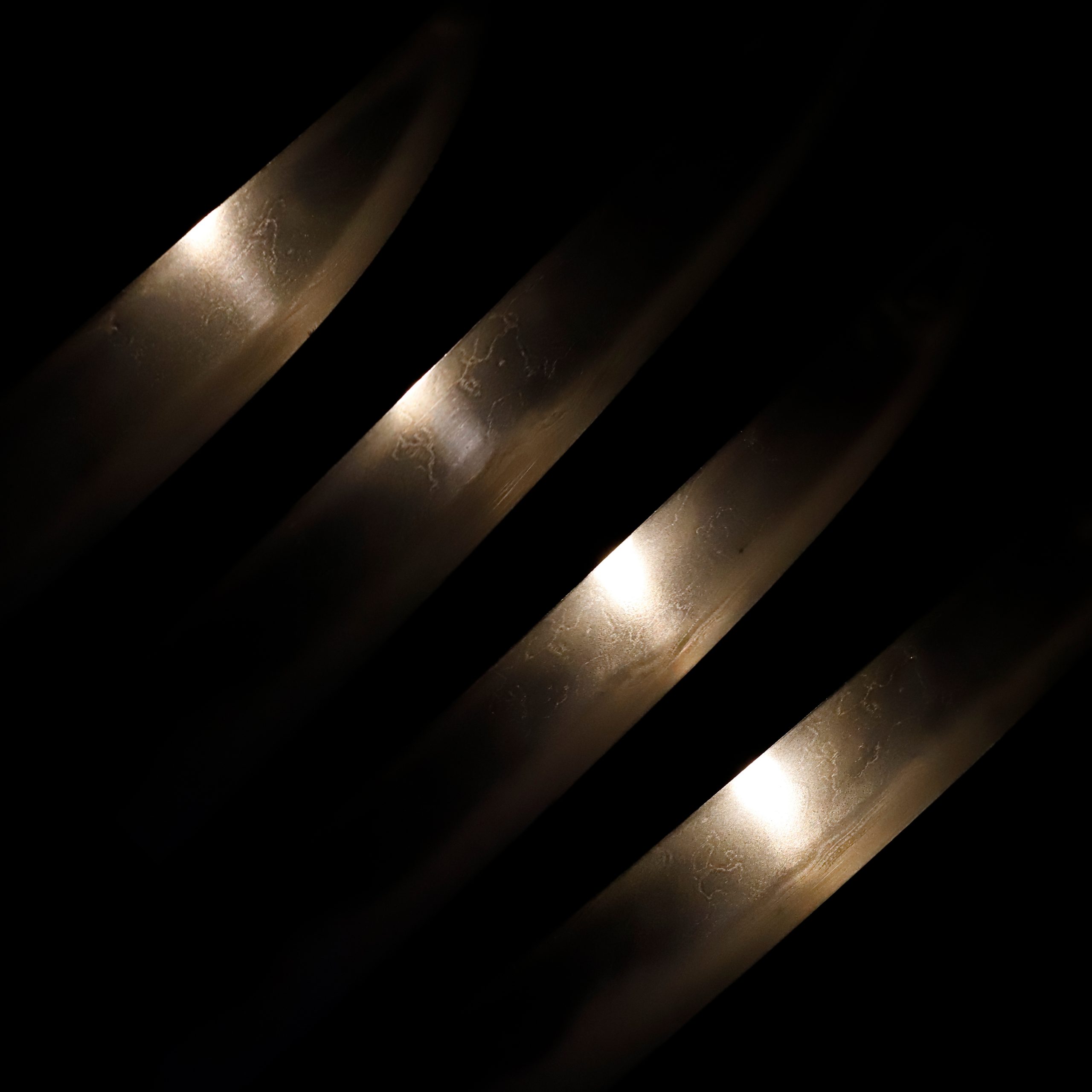
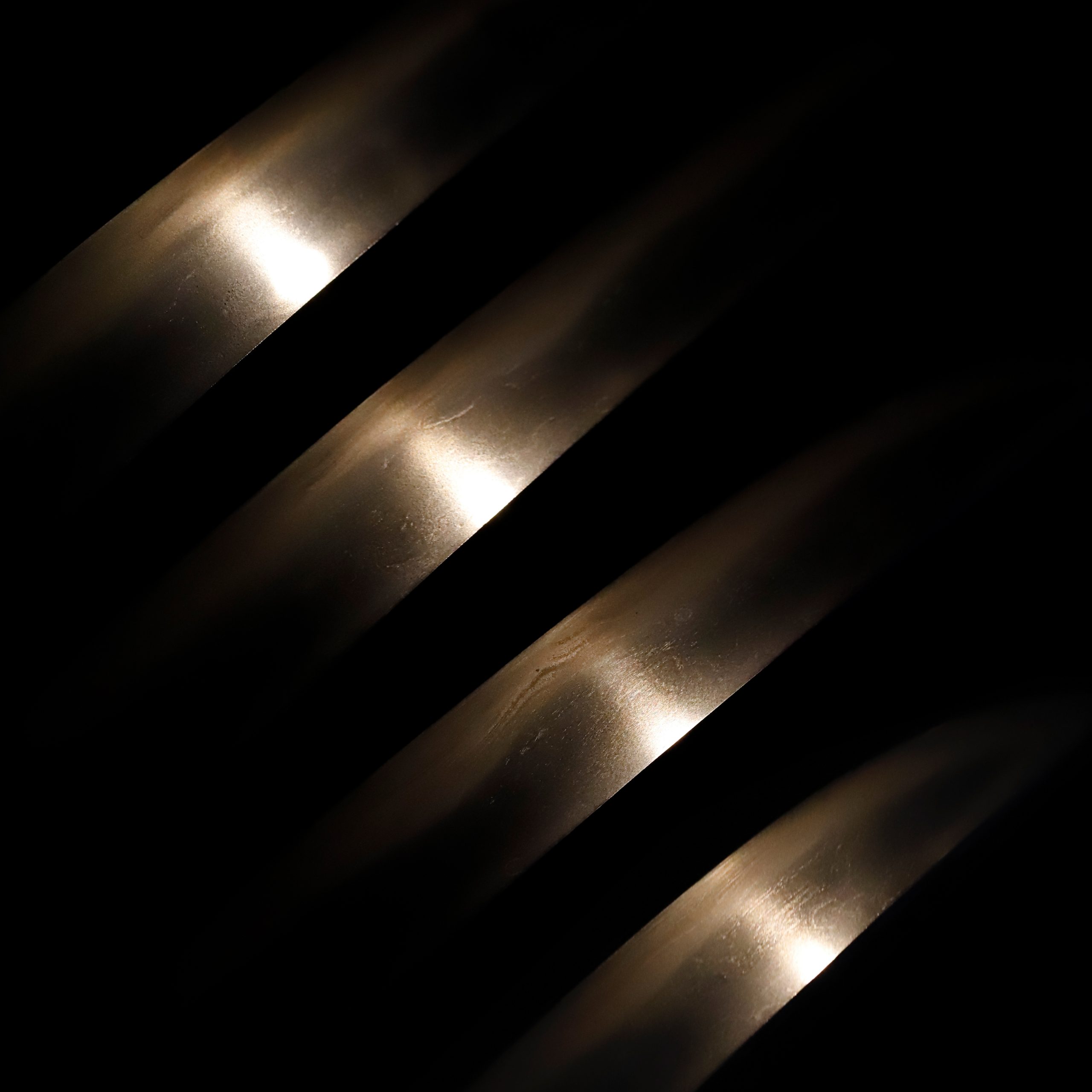
Nakago:Nakago is the tang of the Japanese sword.
Japanese swordsmiths left the black rust on the tang because it prevents red rust while the tang is in its handle. And the discoloration of the tang was created over time, and it is a great indicator for a Japanese sword specialist to estimate when the sword was forged.
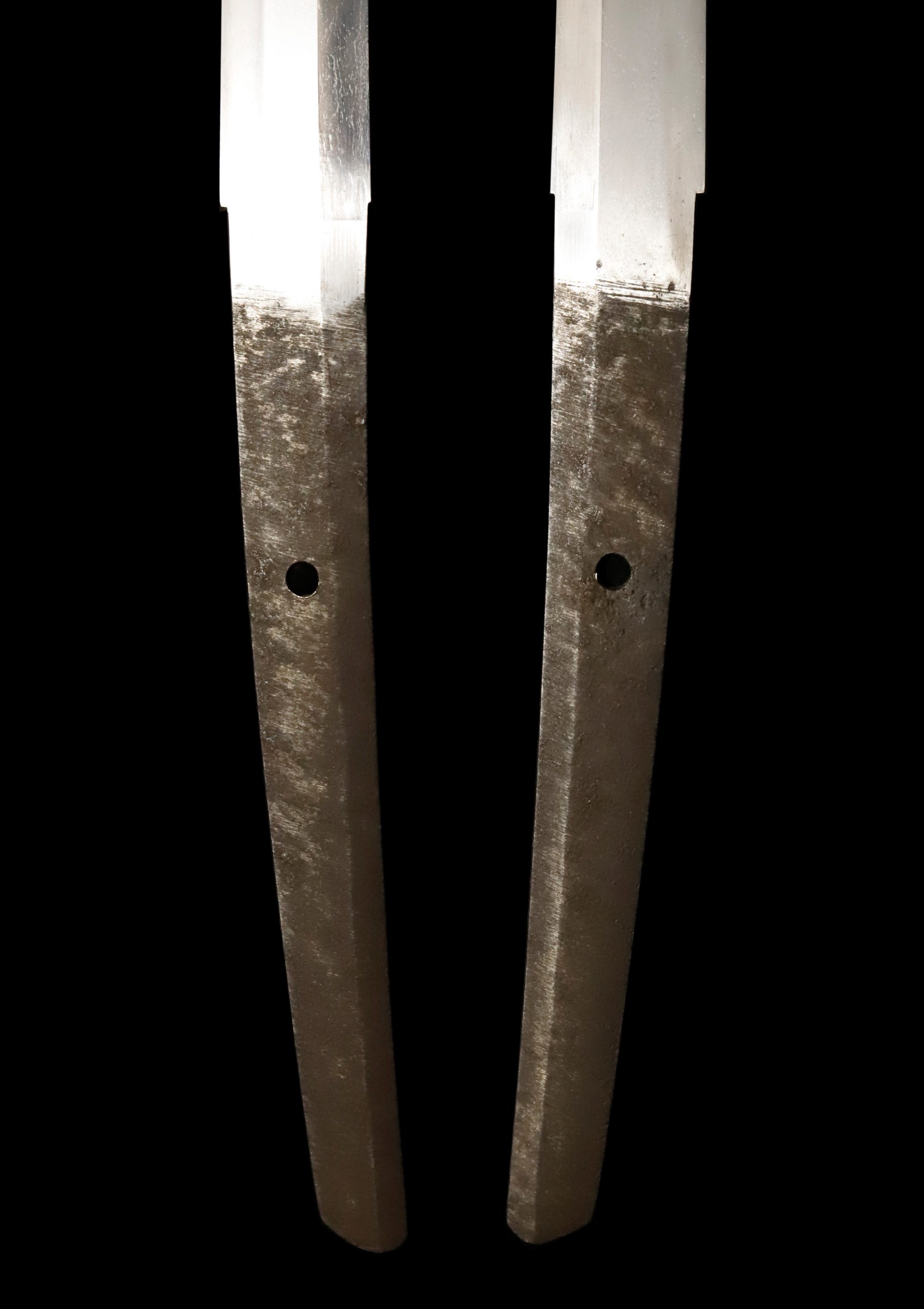
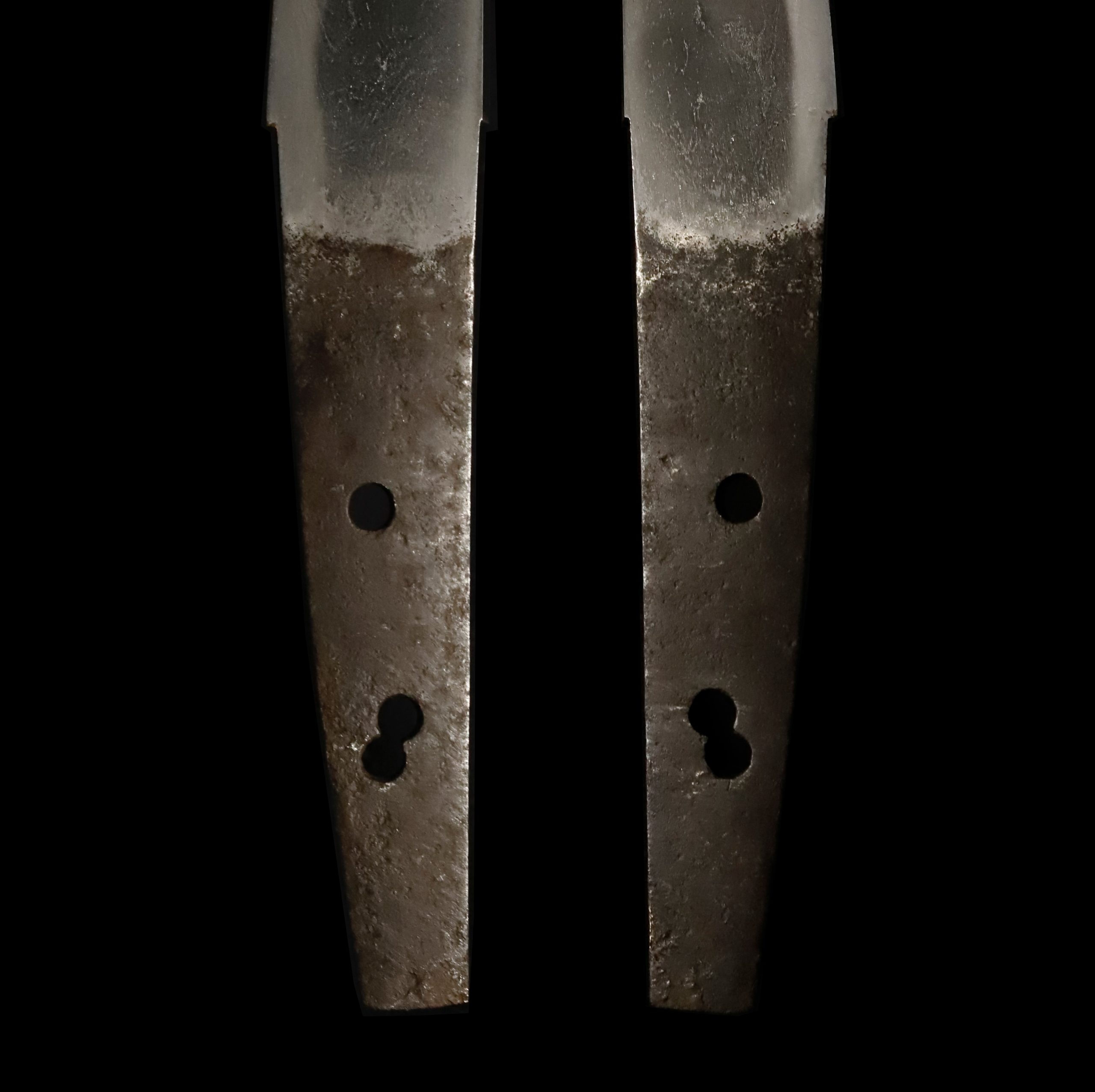
Koshirae: Koshirae is the mounting of the Japanese sword. There are several parts that consist of Koshirae such as Saya(Sabbard), Tsuka(Handle), Tsuba(Handguard).
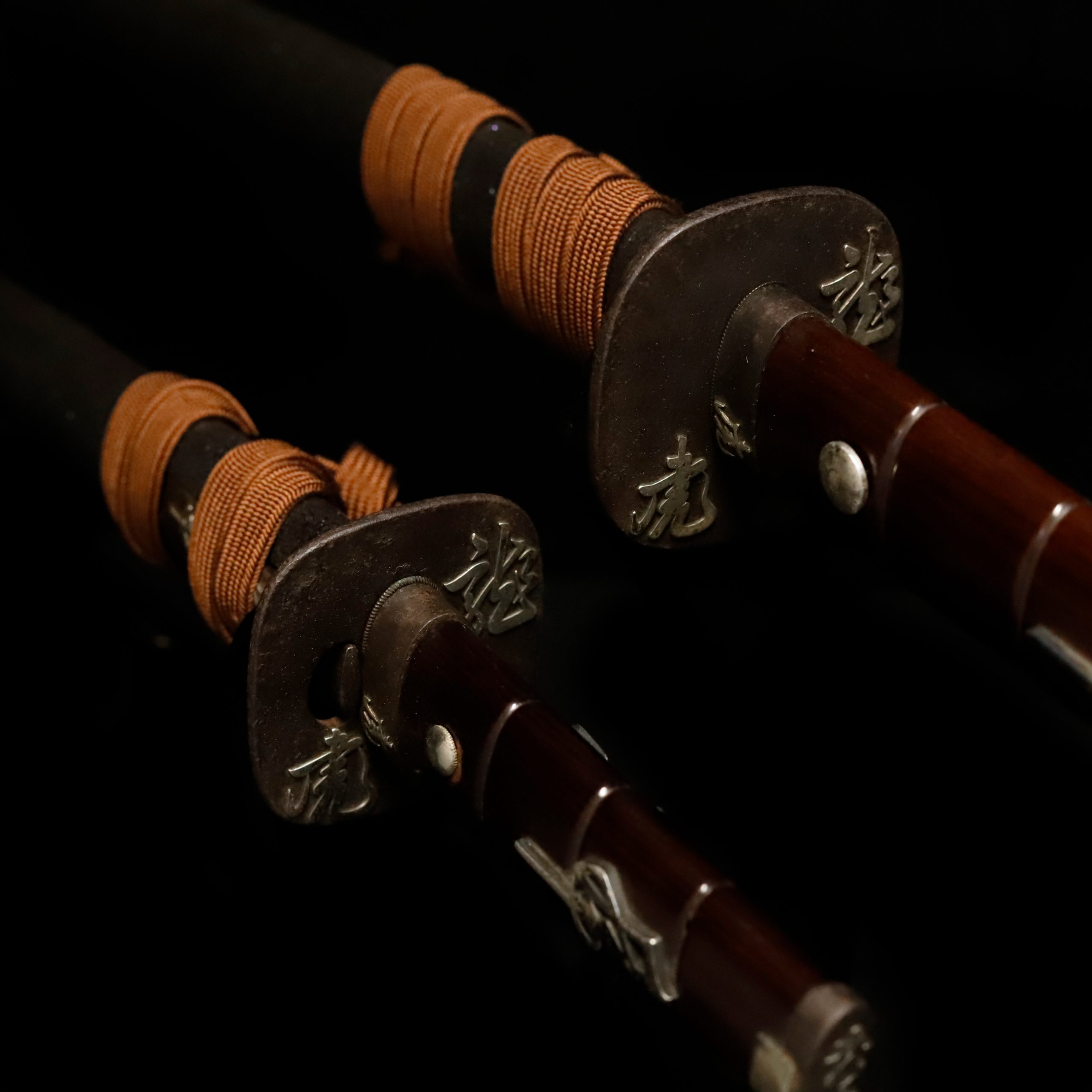
Fuchi-Kashira:A pair of matching sword fittings that cover the upper and bottom parts of its sword hilt.
Although these Fuchi Kashiras do not have any specific designs, Japanese cursive style (or semi-cursive style)-shaped letters are engraved. The first letter might be 龍 (Ryu, means a dragon), and the second letter might be 虎 (Tora, means a tiger). The same shape letters are put for the Tsuba also.
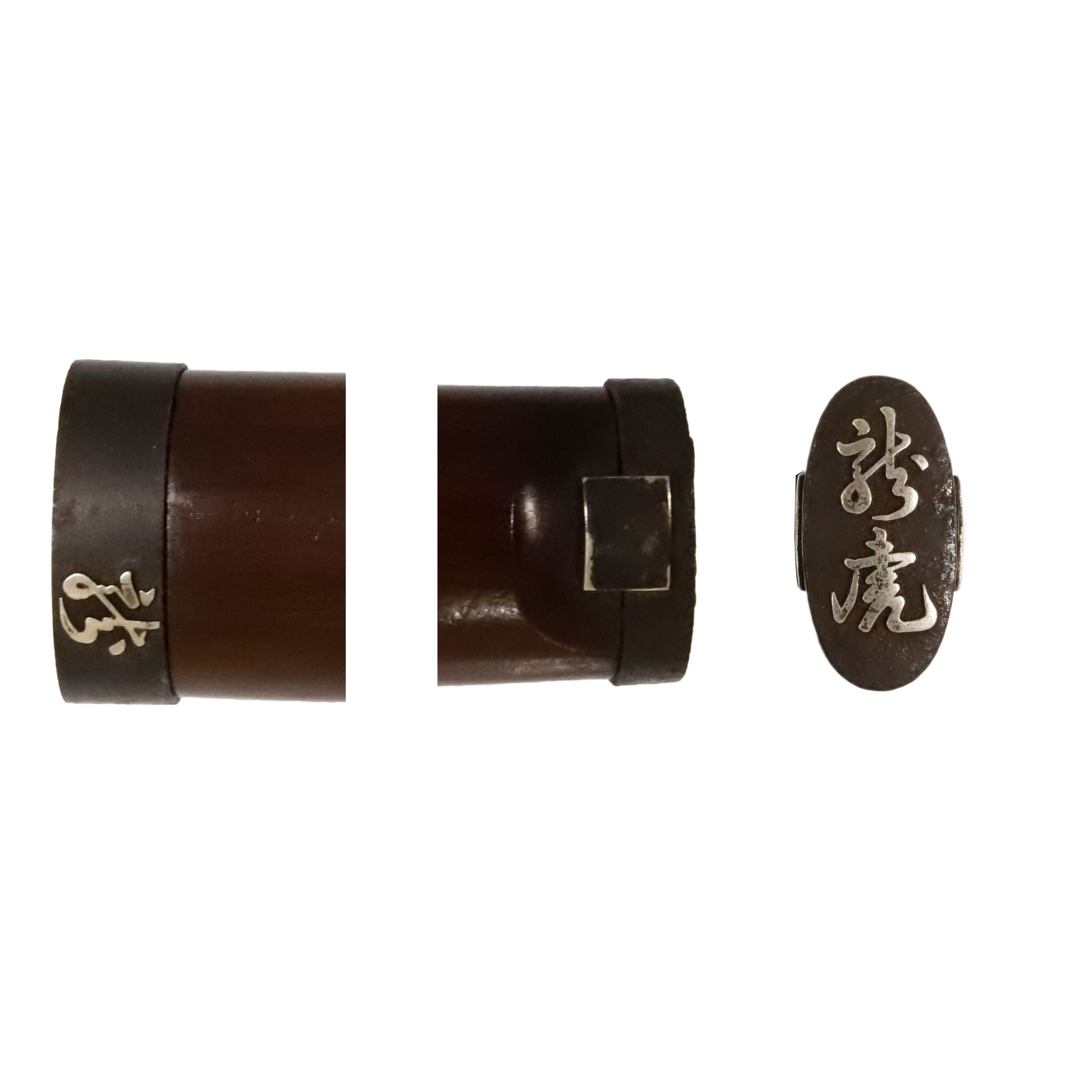
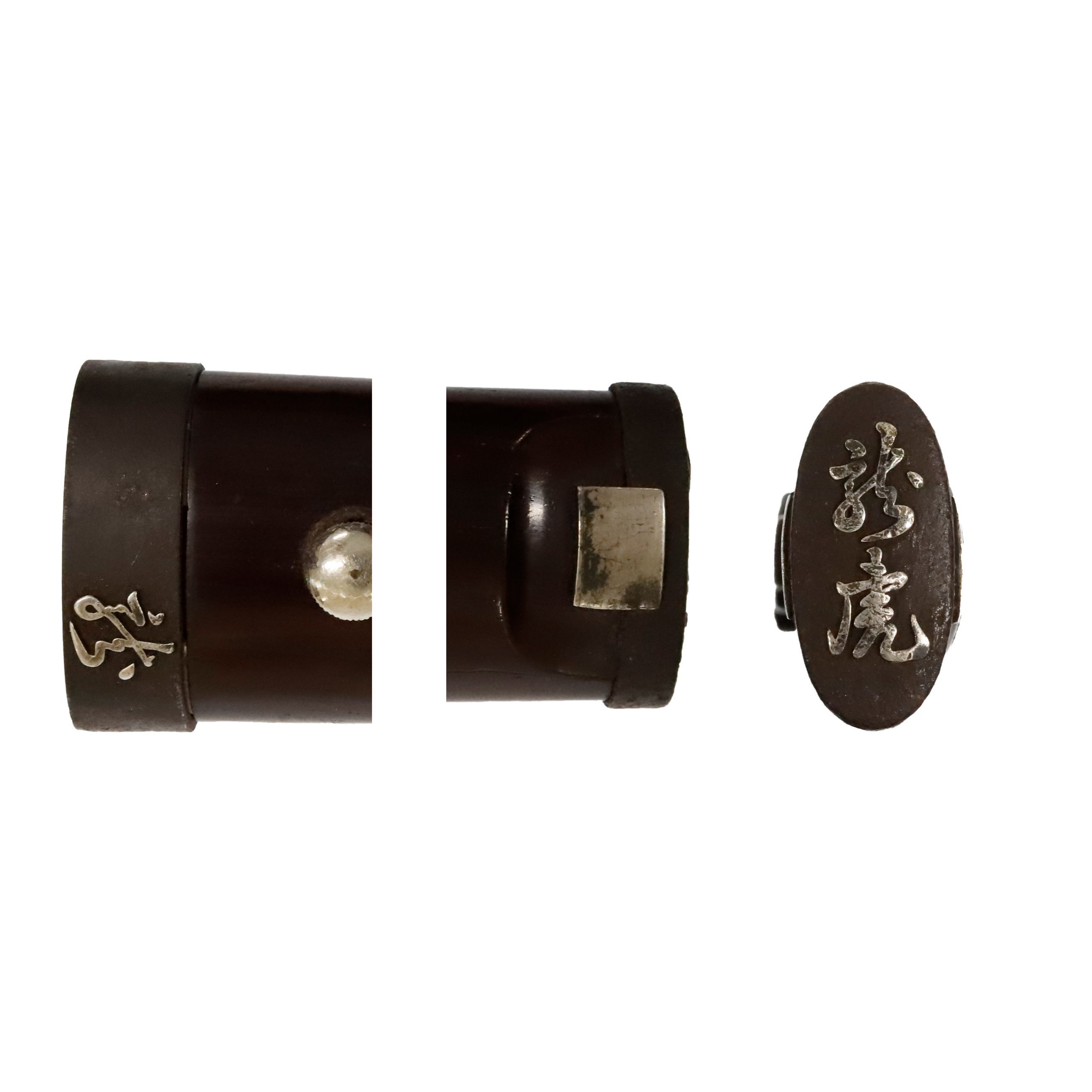
Tsuka and Menuki:Tsuka is the handle of the Japanese sword and Menuki is its decoration.
Same as Fuchi Kashira, Japanese letters are used as motifs of Menuki. It seems one of the letters is 竜 (Ryu, means a dragon same as 龍), and the other one might be 虎. According to a theory, the difference between 龍 and 竜 is, 龍 represents the oriental sacred beast, and 竜 is a western fantasy creature. It is also said 龍 is the old, more complicated form of 竜.
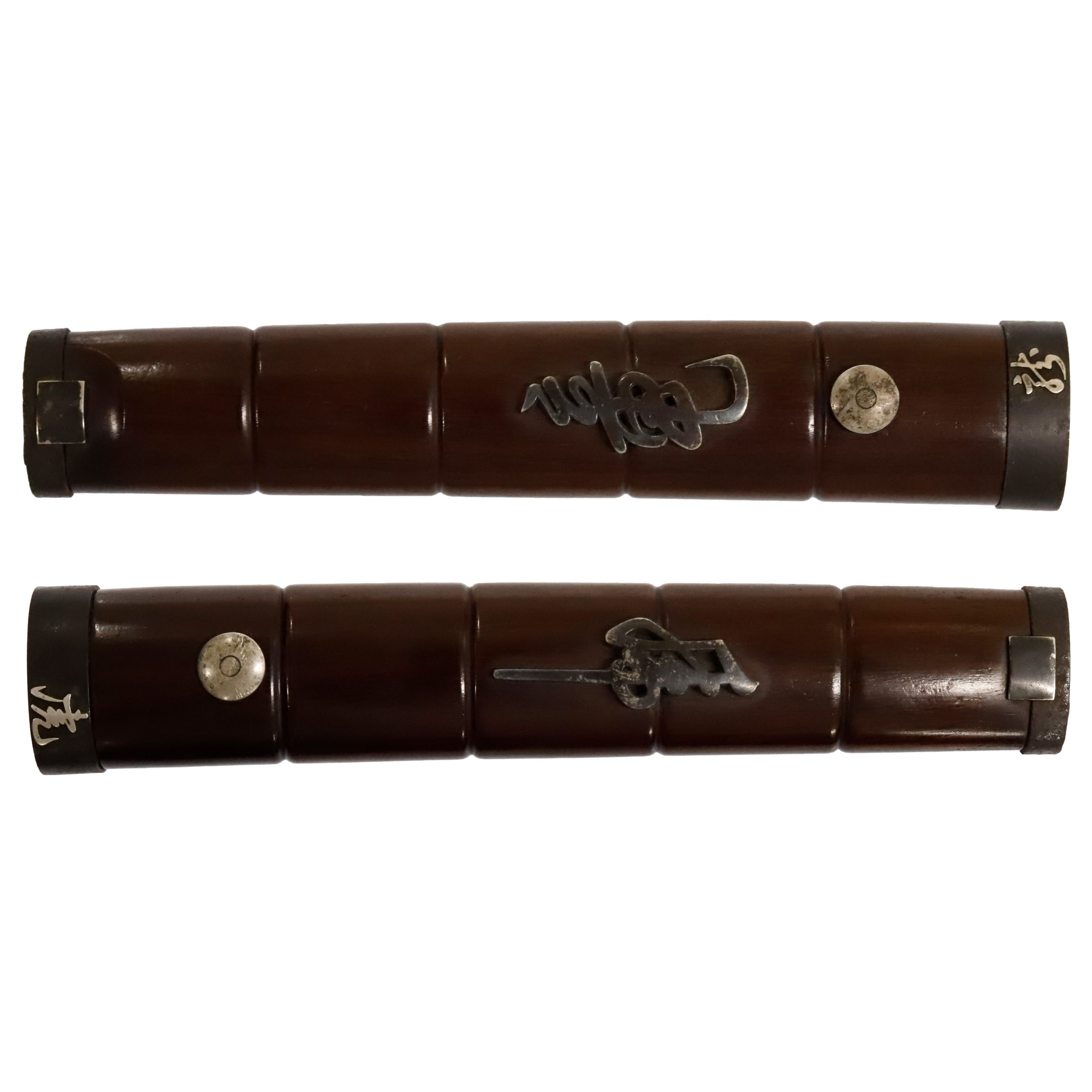
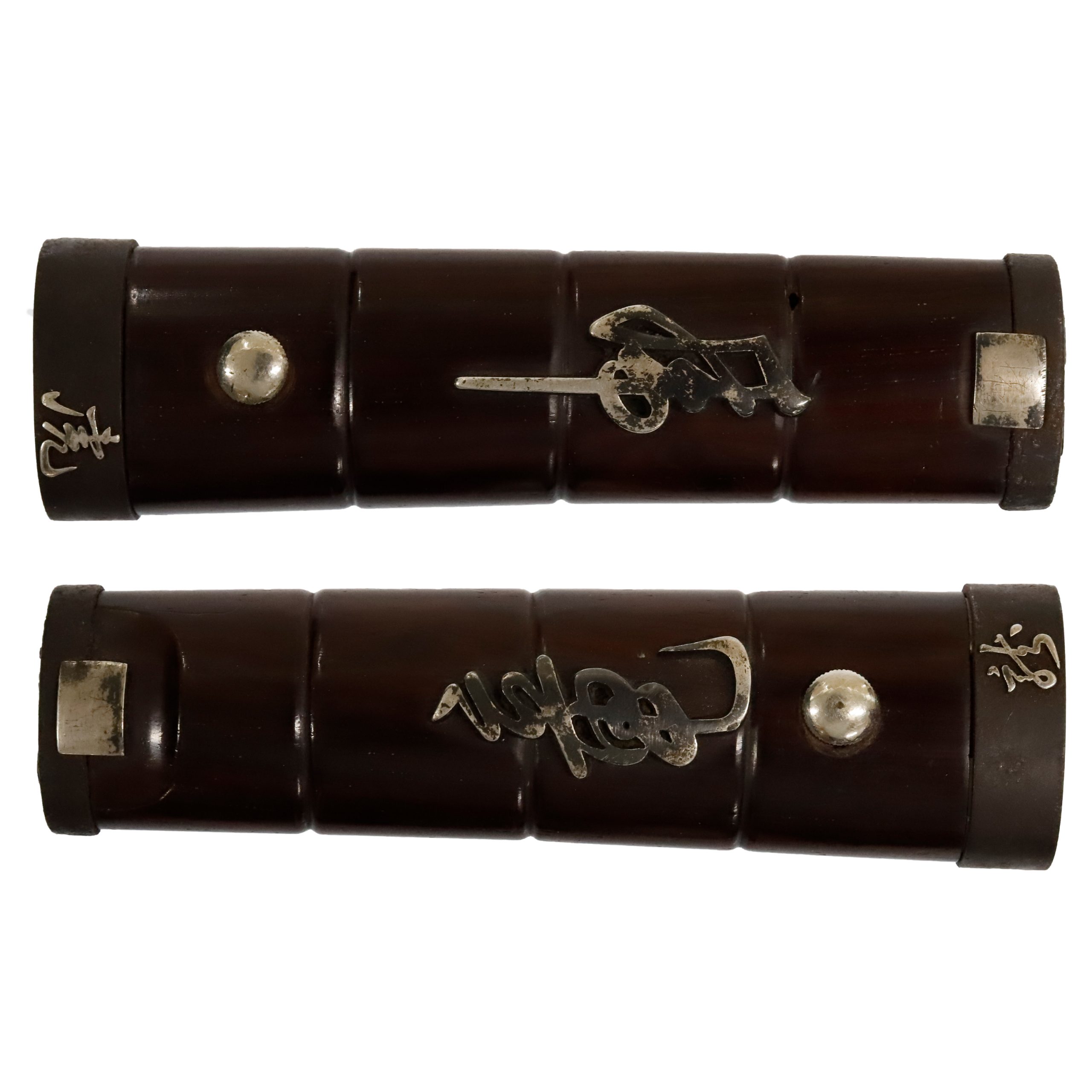
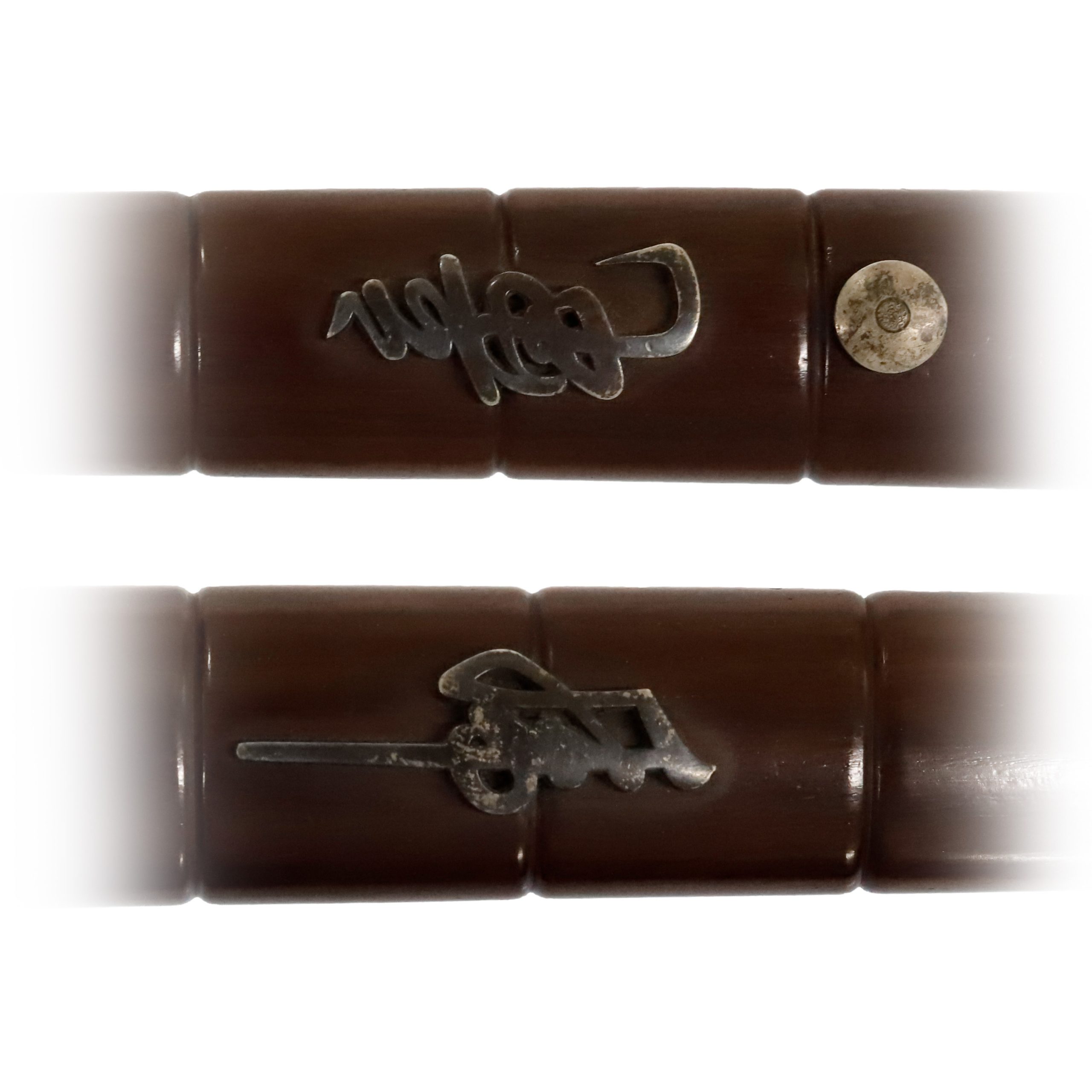
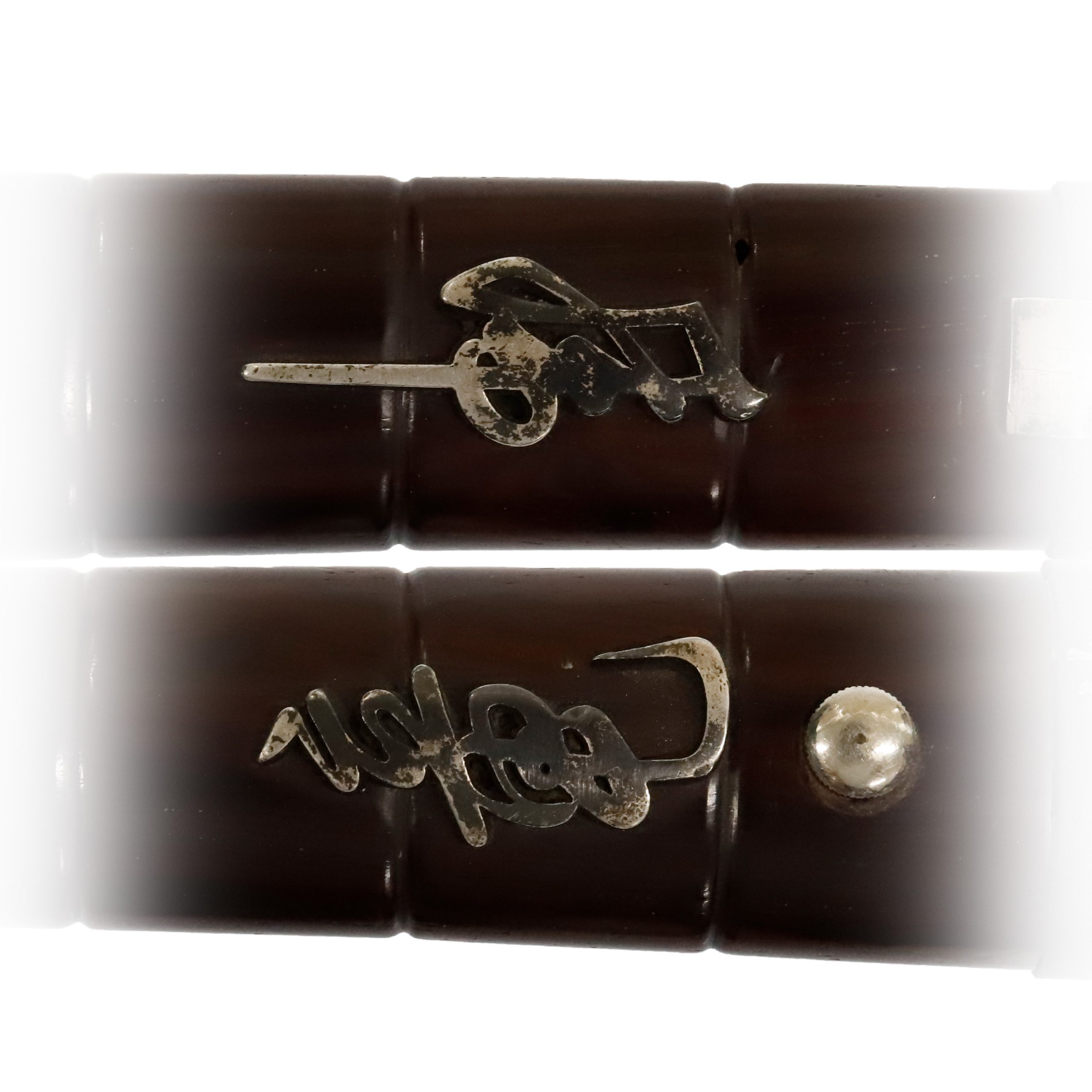
Tsuba and Habaki:Tsuba is the handguard for the Japanese Sword and Habaki is the equipment to make the blade not touch its scabbard inside. It prevents the blade from getting rusty and chipped.
As mentioned above, the exact shape of letters is designed for these Tsubas and Fuchi Kashira. 龍 (We would like to say oriental dragon here), it is initially an imaginary creature found in ancient Chinese traditions or myths. Furthermore, it is a symbolic beast of auspicious signs. Its body is likened to nine animals: antlers are deer, the head is a camel, eyes are demons, the neck is a snake, belly is Mizuchi (蛟, mythical animal in Japan which looks like a snake and have a horn and four legs), scales are fish, claws are falcons, palms are tigers, and ears are cows. It was thought that the dragon would reign at the top of all animals because of its odd-looking appearance.
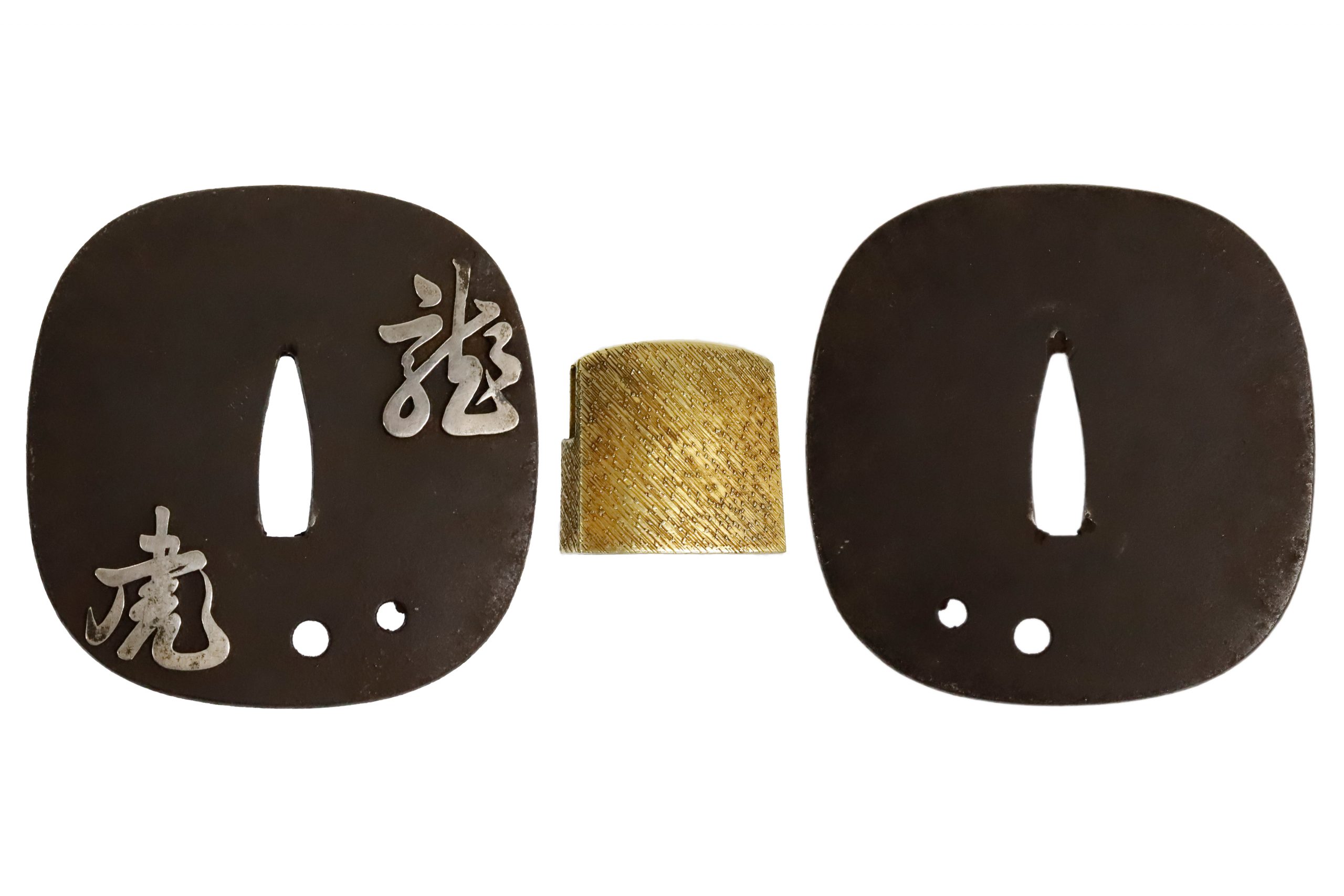
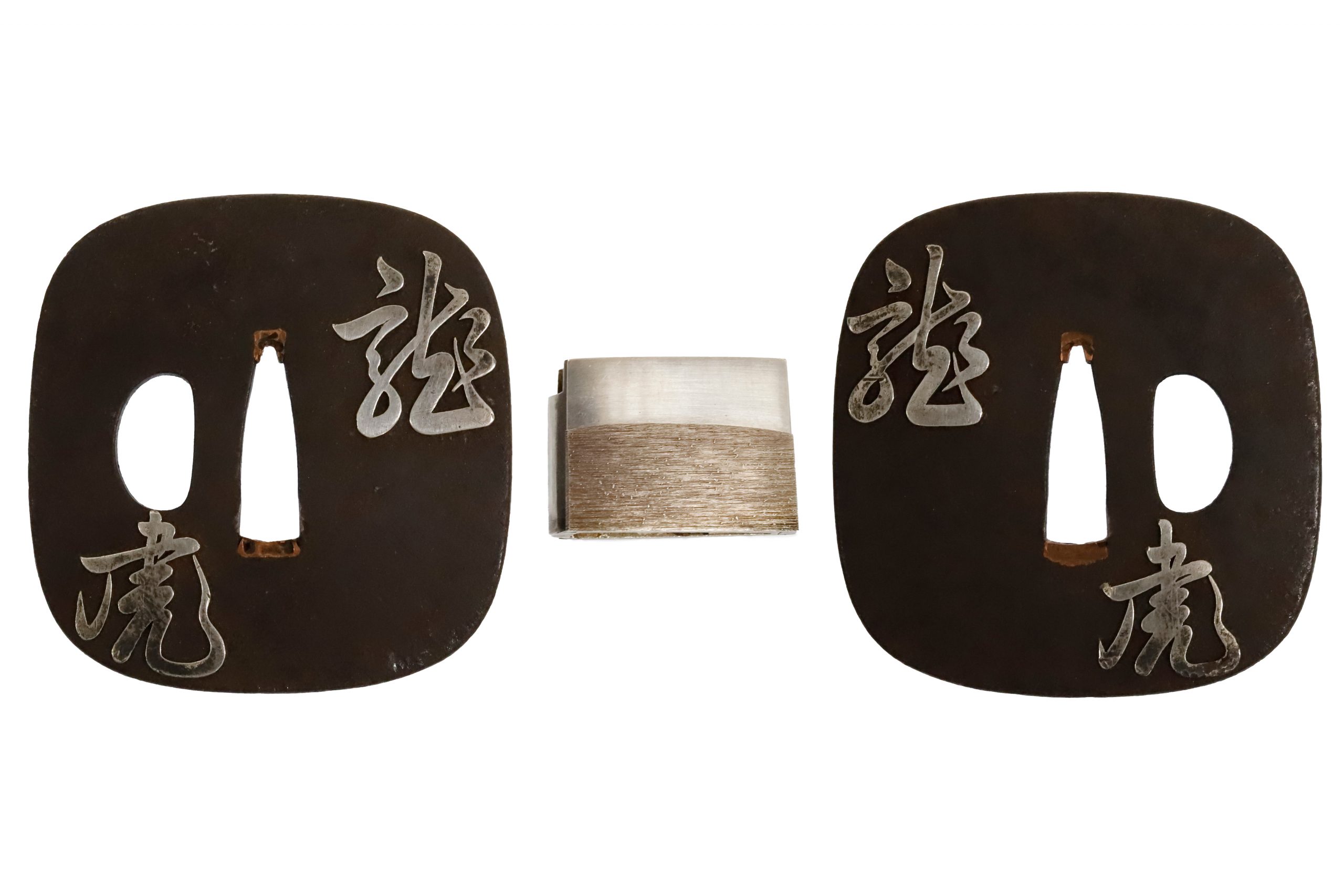
Saya: Saya is the scabbard for the Japanese sword.
Due to the decorative technique of painting, these Sayas have elegant appearances. If you look at pictures by enlarging, you will find that tiny glitters on each Saya. We would guess that its material is seashell. In Japan, there is an ornamental technique that is called Raden (螺鈿). It has been often used for traditional craftworks. It uses the pearl part of seashells and puts it into the engraved surface of lacquer or wood. Thanks to its iridescent luster, it gives a luxurious look to works.
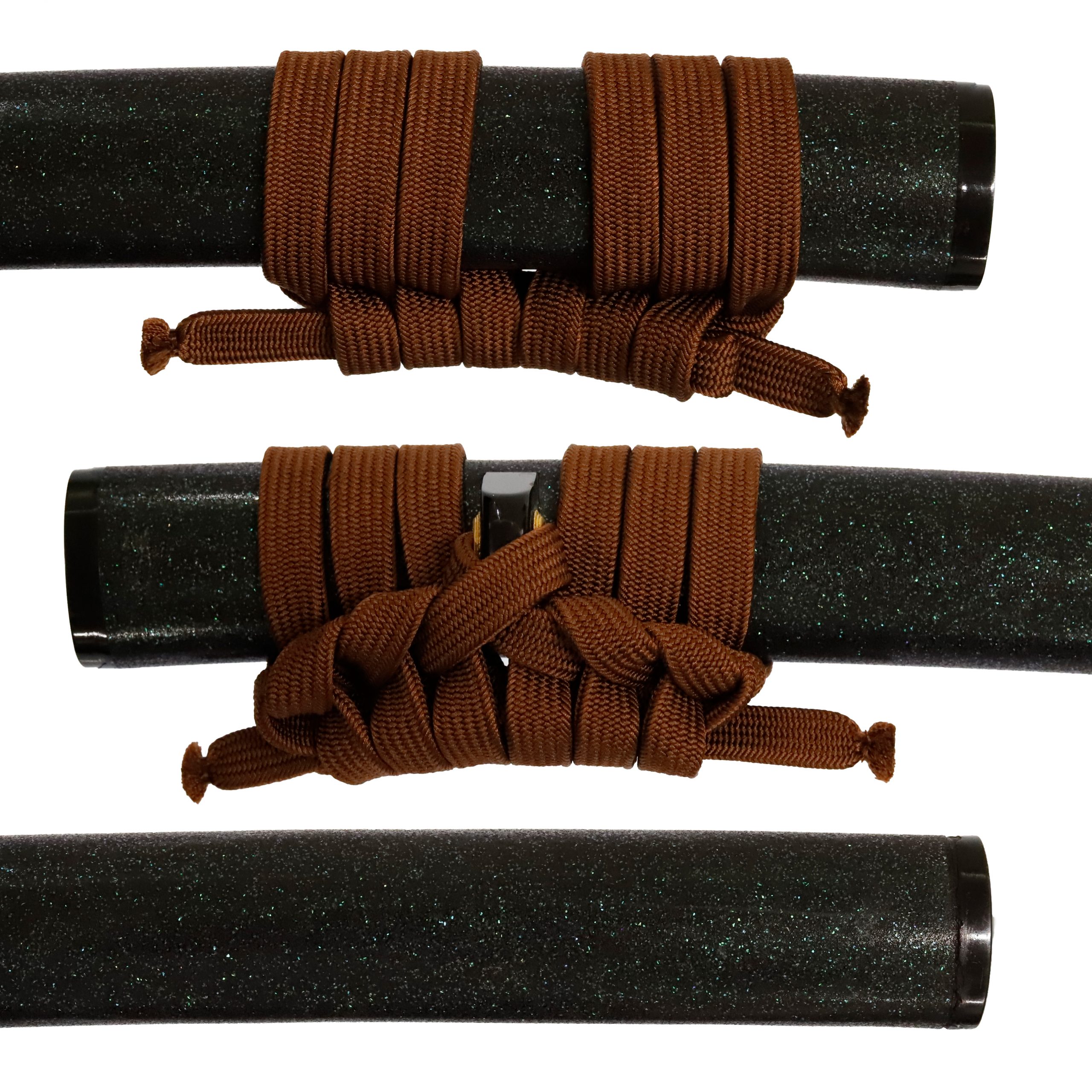
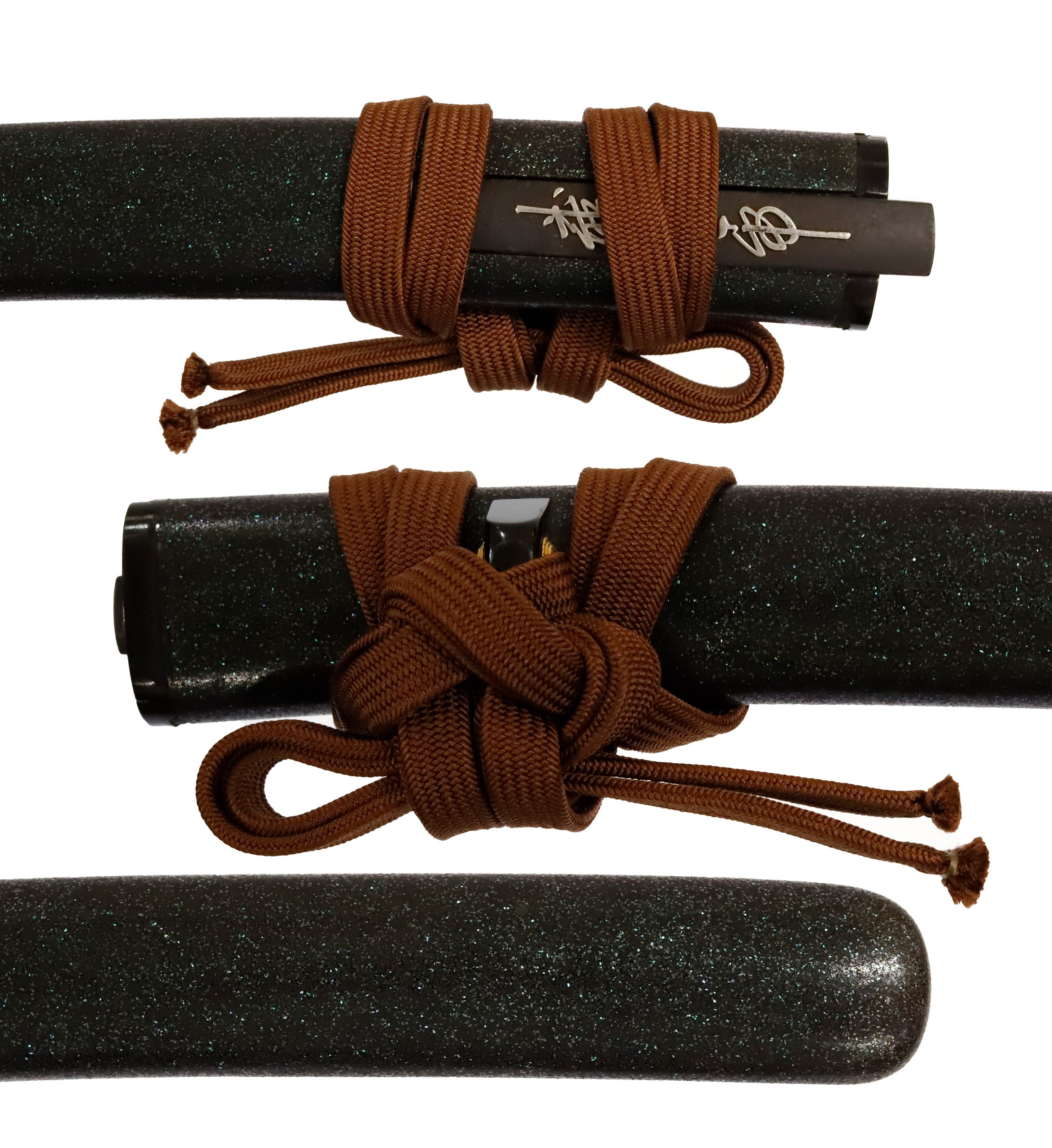
Kozuka:Kozuka is a small knife stored in Kozuka Hitsu(groove of the sheath of the Japanese sword).
Kogatana (tiny knife) is stored in Kozuka. Same as other sword mountings, two Japanese letters are engraved and colored with silvery metal. If these letters expressed 龍 and 虎, we would quote a famous theme of painting; 龍虎図 (Ryu-Ko Zu). It is a combination of dragon and tiger. There is a theory that believes the dragon will bring clouds, and the tiger will make winds. Both of them are regarded as sacred beasts who control the weather. It is said that many Samurais and Zen priests loved this theme from the middle of the Muromachi period.
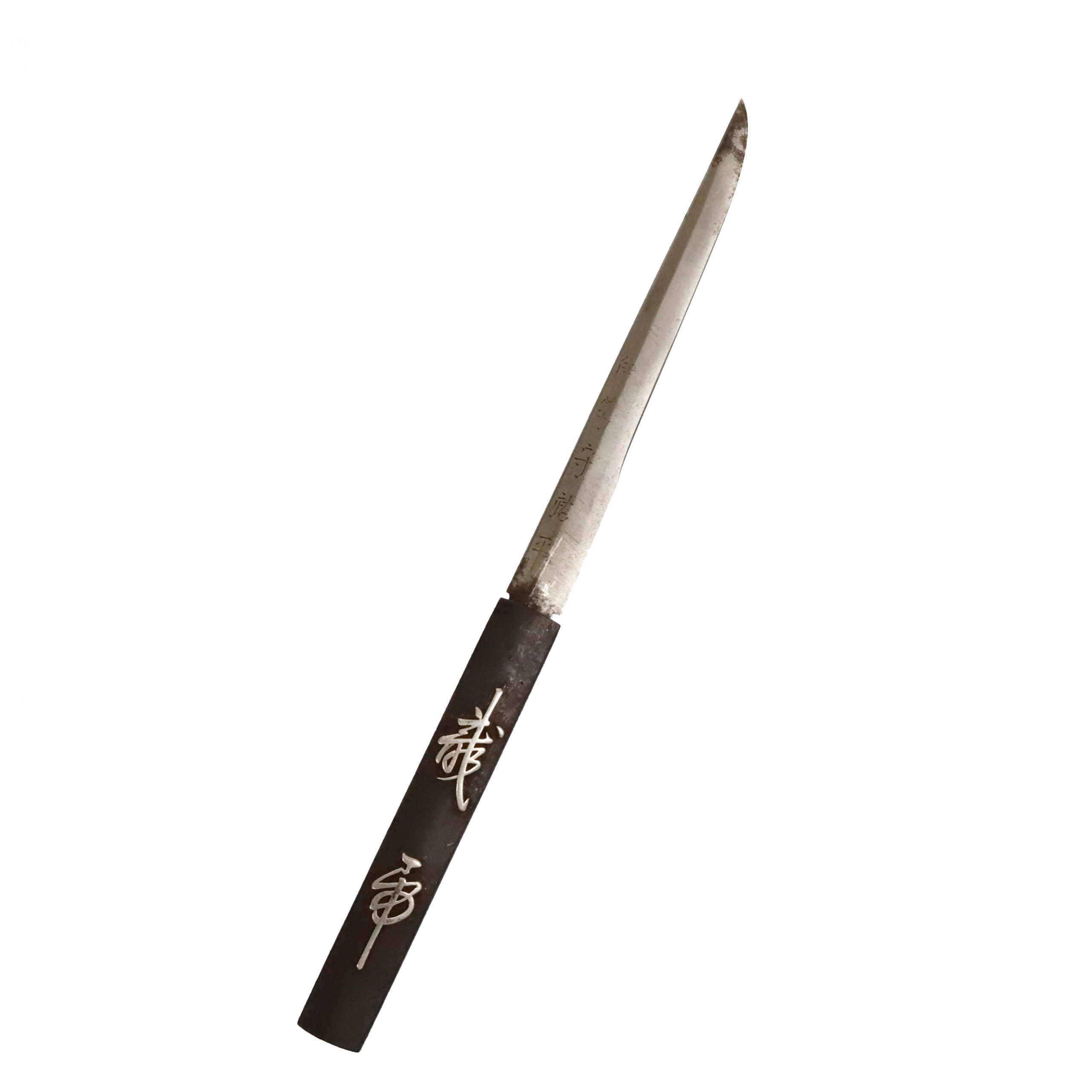
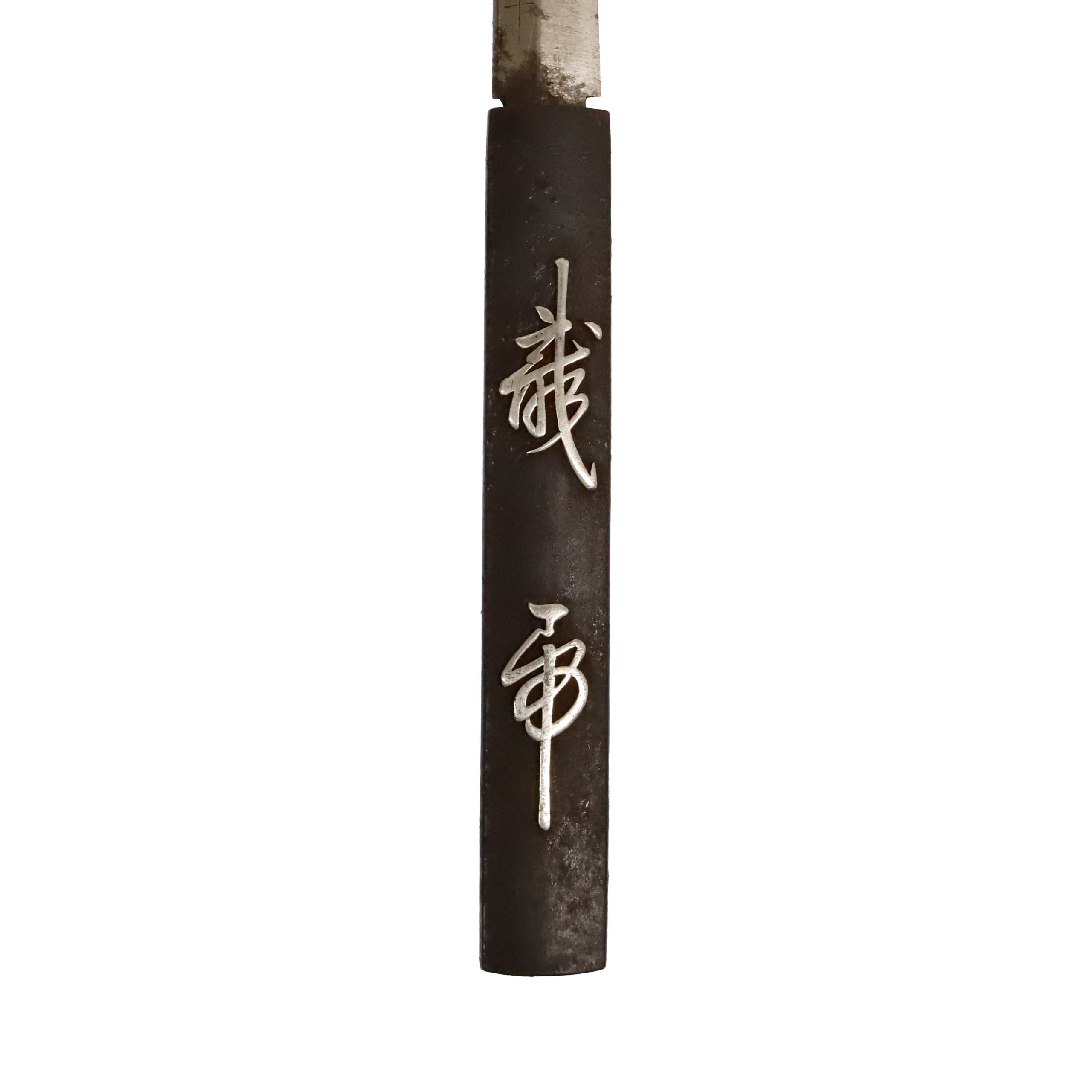
Reference:Hon-Ami Nisshu Kofuda

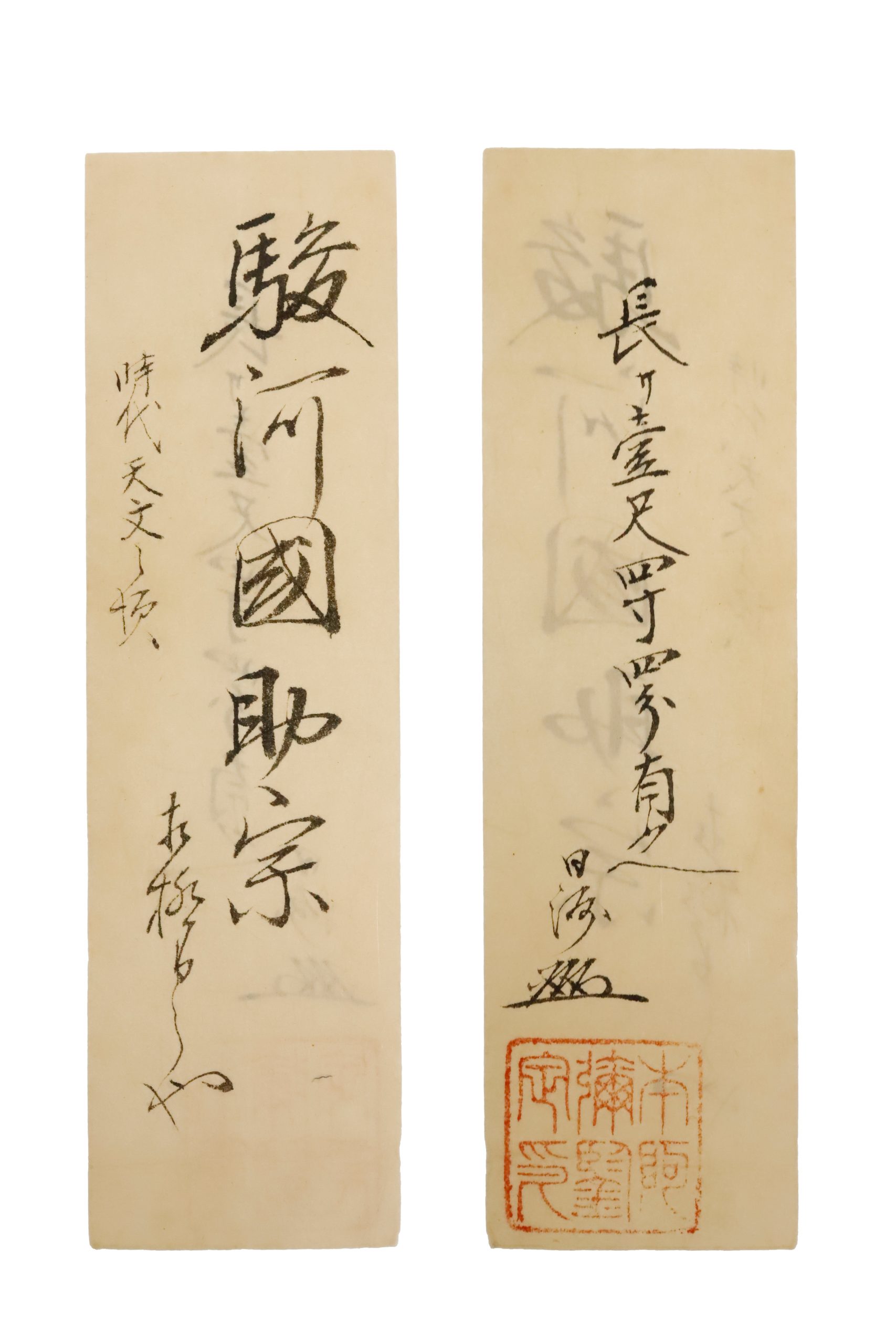
Registration Number : Tokyo 64600,64601
The Board of Education in Tokyo prefecture issued a registration paper for this sword . In order to obtain this paper, the sword needs to be traditionally hand forged. With this paper, its owner can legally own an authentic Japanese sword in Japan. This paper will need to be returned to the board of education when the sword being shipped abroad but you can receive a copy of it.
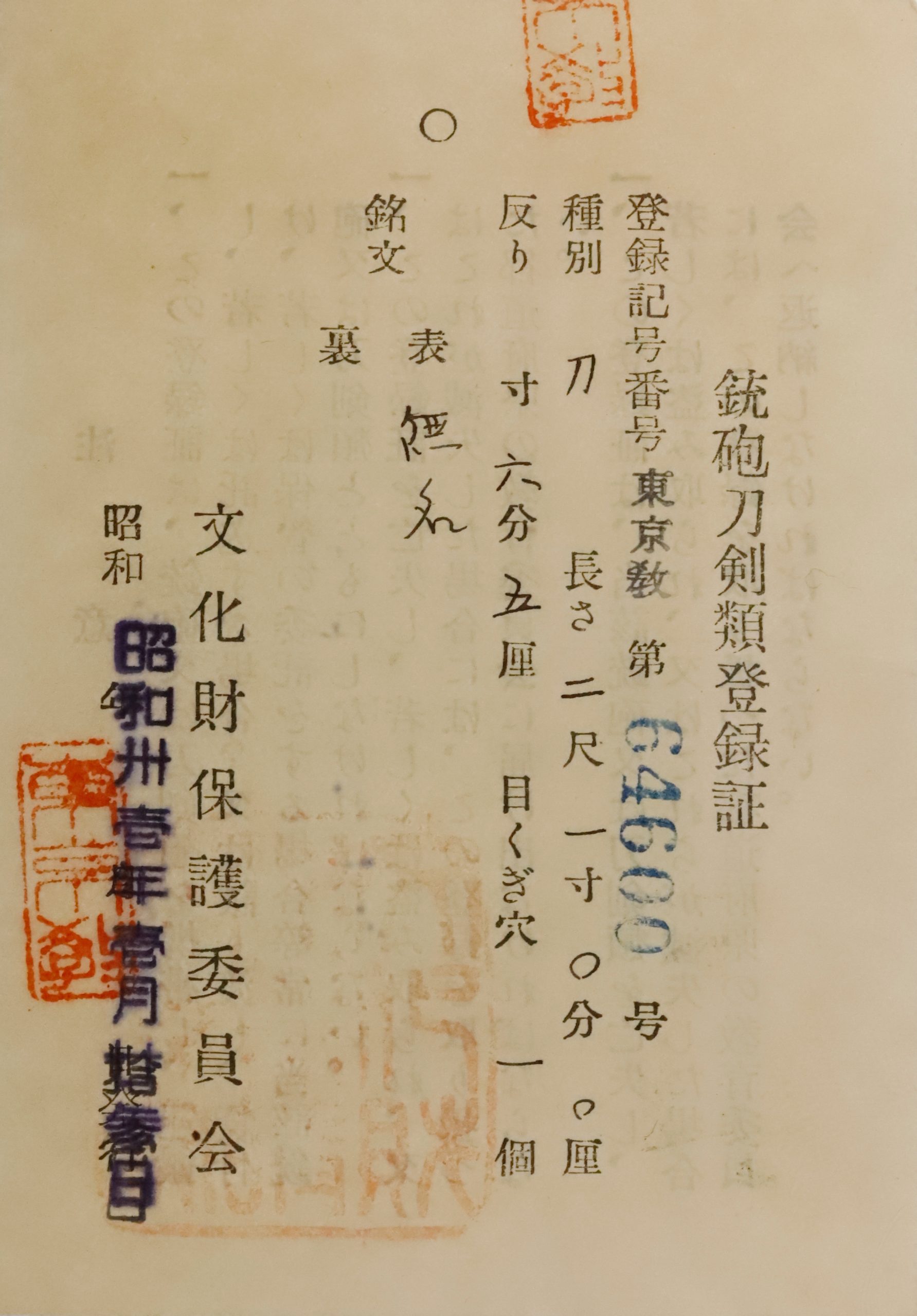
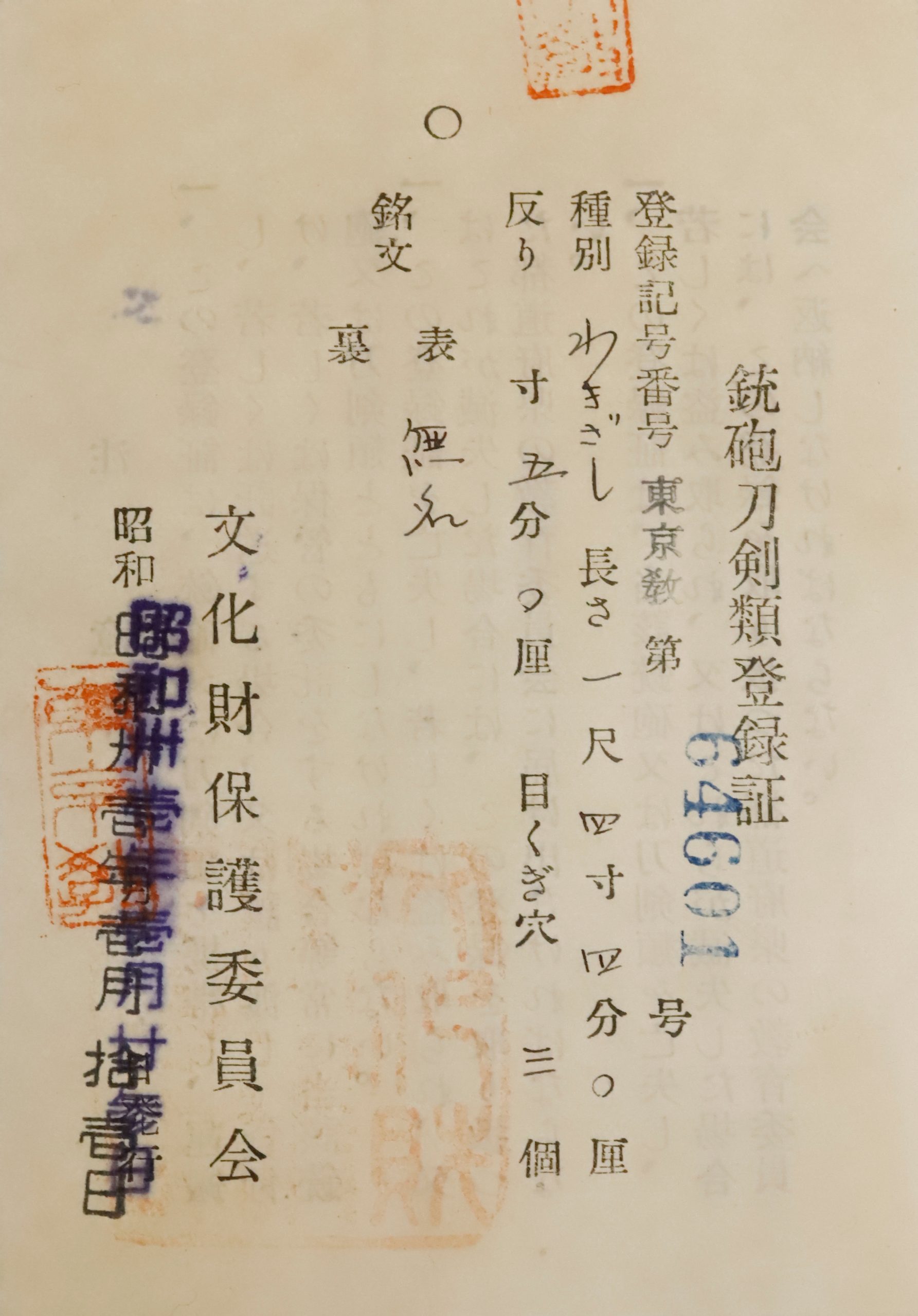
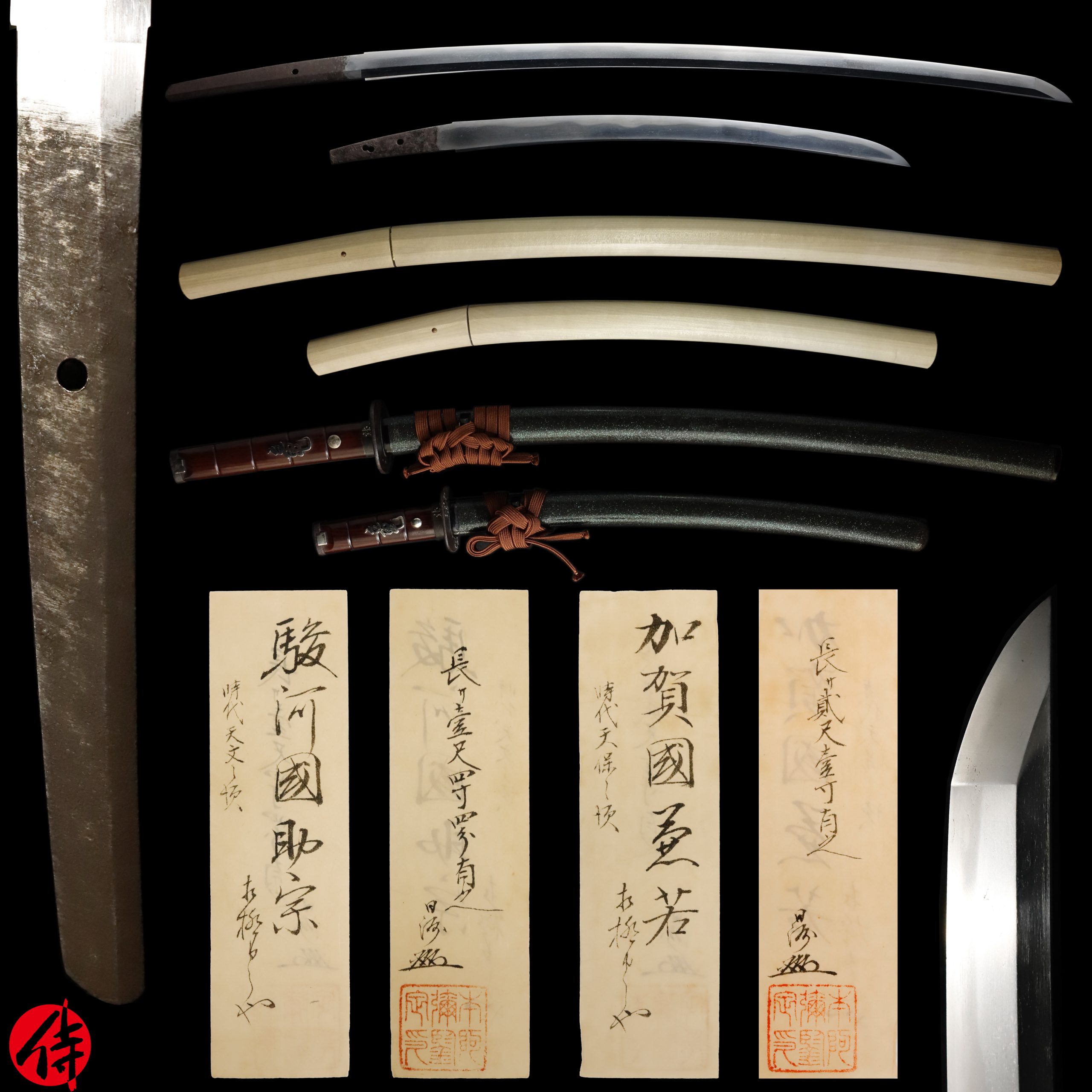
—————————————————————–
【About us】
Samurai Museum is located in Tokyo, Japan, exhibiting antique artifacts related to the Samurai history. Samurai Museum Shop is the place for those who are interested in Japanese culture and craftsmanship. We deal with antique Samurai swords/armor, traditional crafts made in Japan and so on.
【Japanese Sword& Export Process】
The Japanese swords we deal with are hand-forged edged swords made in Japan. It was made from the traditional carbon steel called TAMAHAGANE(玉鋼). Samurai Museum is familiar with the proper legal procedure for an antique/ authentic Japanese sword to be exported from Japan. We have sent more than 300 Japanese swords to amazing owners who appreciate its historical value.
Each Japanese sword is registered under the Agency for Cultural Affairs and the Board of Education in Japan.They issue a registration paper for each Japanese sword for its owner in Japan to legally possess it. The Japanese sword with its registration paper means it was traditionally hand-forged in Japan.
To legally export the sword from Japan to other countries, we will have to apply for its permit to the Agency for Cultural Affairs(Bunkacho) and return the original registration paper to the Board of Education. It normally takes around 2-4 weeks to receive this permit after submitting required documents. And we would like you to expect at least 1-1.5 months for your order to arrive at your given address after you ordered. For more detailed info, please click here.
It is allowed for residents in Japan to own authentic Japanese swords without a special license as long as they come with registration papers. Please feel free to contact us if you are a resident of Japan, whether temporarily or permanently. We will also assist you when you leave Japan and need to obtain the export permit.
【Payment Method】
We accept payment through Stripe(Credit card), PayPal, Apple Pay or ChromePay, all of which are secure payment methods. If you prefer other payment method, please contact us. After confirming your payment, we will apply for an export permit. You may either pay in JPY, USD, AUD, EUR or GBP. The price is set in Japanese Yen. Prices in other currencies are automatically calculated based on the latest exchange rate.

【Shipping】
We have shipped authentic Japanese swords to the USA, Canada, Mexico, UK, Germany , France and Hong Kong. If you don’t live in these countries and like to order, please contact us first before making a purchase. We offer Free International Shipping as long as we can send antique Japanese swords by either EMS or FedEx(Canada).
We will send you a tracking number for your order as soon as we hand it to the post office/FedEx. We will put 100 % insurance on the shipping document without any extra charge. Based on the total amount, there might be a duty tax or other fee for you to pay, depending on the countries. We use package cushioning to protect the item and put it in a PVC pipe, which is one of the most secure packages because of its durability.
It will normally takes 5-14 days for the item to arrive at your given address after we dispatch it. Time of delivery is estimated as accurately as possible by the carrier but does not take into account any delays beyond our control such as by inclement weather, post office holiday seasons.
*Please keep in mind that due to the spread of COVID-19, there might be delays in shipping. If you like to know the detail about shipping, please feel free to ask us.

【How to make sure the condition】
Please keep in mind that what you are going to purchase is an antique item. We uploaded high resolution photos for you to check its condition thoroughly. If you like to see more photos with different angles, please feel free to contact us. We will be happy to send them to you so that you can make informed decision. It is essential for us to know that you are happy with your choice of a sword. and we are prepared to use the best of our ability to serve you.
【The Art of Nihonto(Japanese Sword)】
Samurai’s history is a profound, eloquent legacy of ancient Japanese warriors in which millions of people worldwide are being fascinated. If you like to find out the art of Nihonto, please click here.
【A Guide to Japanese Sword Maintenance】
After acquiring an genuine Japanese sword, it is also important to know how to take good care of it. Here is the special video for you. Mr. Paul Martin, Japanese sword expert, shows you how to give proper maintenance to your sword. When you purchase a Japanese sword from us, you can get a Free sword maintenance kit, which appears in this video.

